After the heat of summer, your garden may be looking a bit drab and lackluster. Perhaps your flowers have faded, weeds have gotten a little wild or maybe you’re even dealing with a touch of powdery mildew on your ornamentals. There are so many reasons why your garden may need a little “pick me up” in autumn and why fall is such a great time to plant some new flowers.
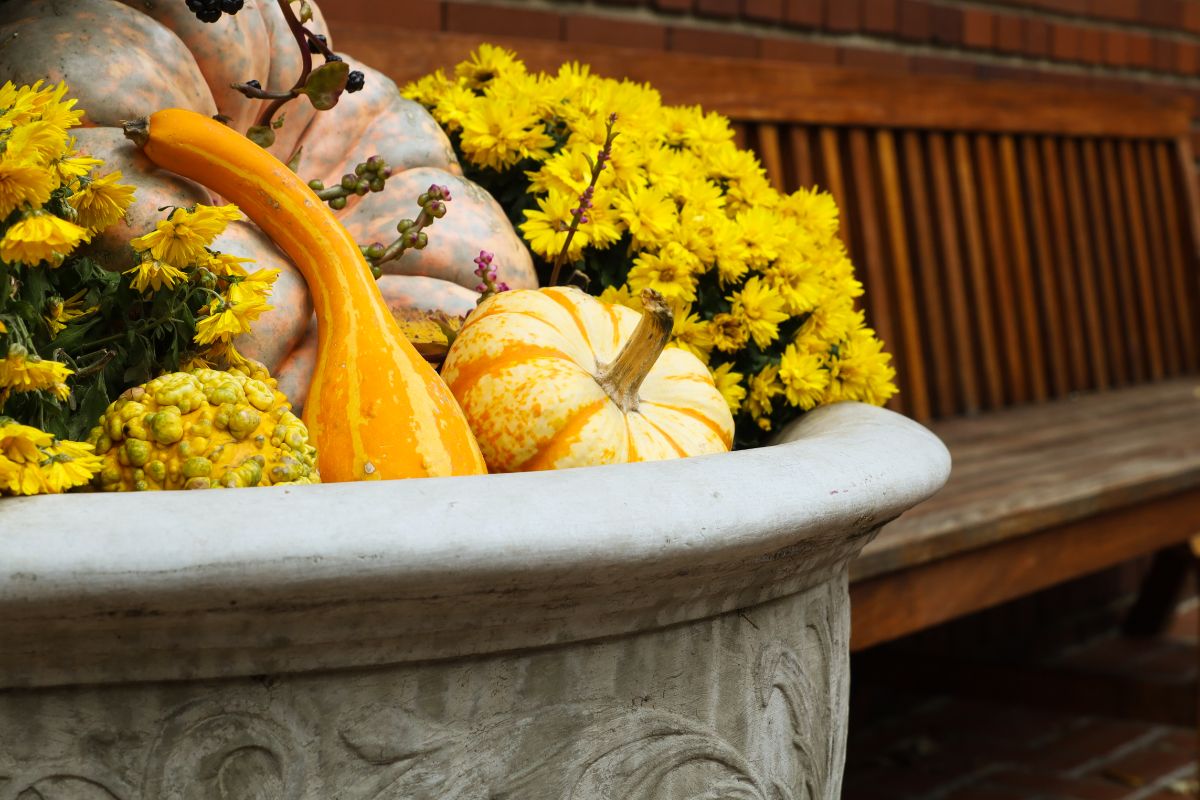
Planting a few mums or asters in your flower beds or container gardens towards the end of the season is a wonderful way to breathe new life and color into your outdoor space. But beyond that, the cooler temperatures of autumn make it the perfect time to get bulbs and some ornamental flowering bushes in the ground too.
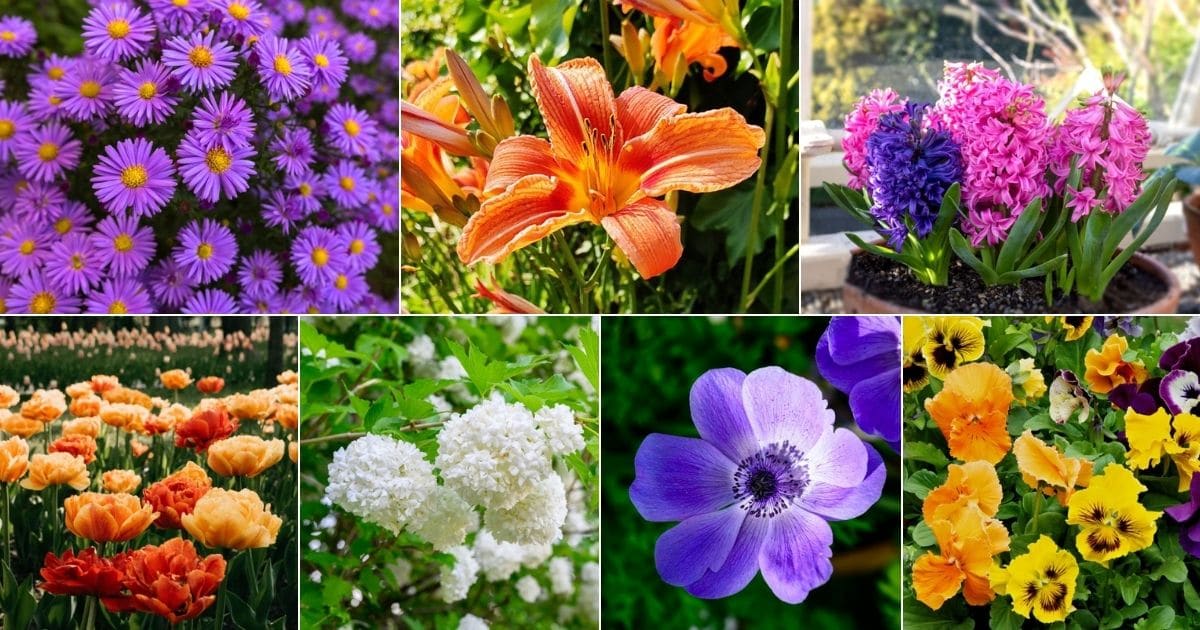
In this article we’ll introduce you to our favorite fall flowers and provide some tips and tricks about how to plant them successfully for optimal blooms.
So don’t stow away your garden shovel just yet. There’s plenty of planting still to do in fall!
Jump to:
- What sorts of flowers are best for fall planting?
- Top 21 flowers for fall planting
- 1. Crocus
- 2. Tulips
- 3. Hyacinth
- 4. Daffodils
- 5. Alliums
- 6. Peonies
- 7. Lilies
- 8. Bluebells
- 9. Grape hyacinth
- 10. Lily of the Valley
- 11. Snowdrops
- 12. Anemones
- 13. Fritillaria
- 14. Mums
- 15. Nasturtium
- 16. Pansies
- 17. Goldenrod
- 18. Asters
- 19. Hydrangea
- 20. Viburnum
- 21. Lilacs
- Where to buy bulbs?
- When should I plant bulbs?
- How do I find my region’s first and last frost date?
- Basics of autumn bulb planting
- Conclusion
What sorts of flowers are best for fall planting?
Well that depends. First you need to ask yourself what your goal is for your autumn planting? Are you hoping for lots of bright fall-blooming flowers now? Or are you looking ahead to the future and planning next season’s garden with spring-blooming bulbs and long-lasting perennial plants and shrubs?
Answering these questions will help you determine whether you should direct your attention to fall-blooming flowers or if you should, instead, try planting some bulbs or slower growing perennials that are best sown in autumn.
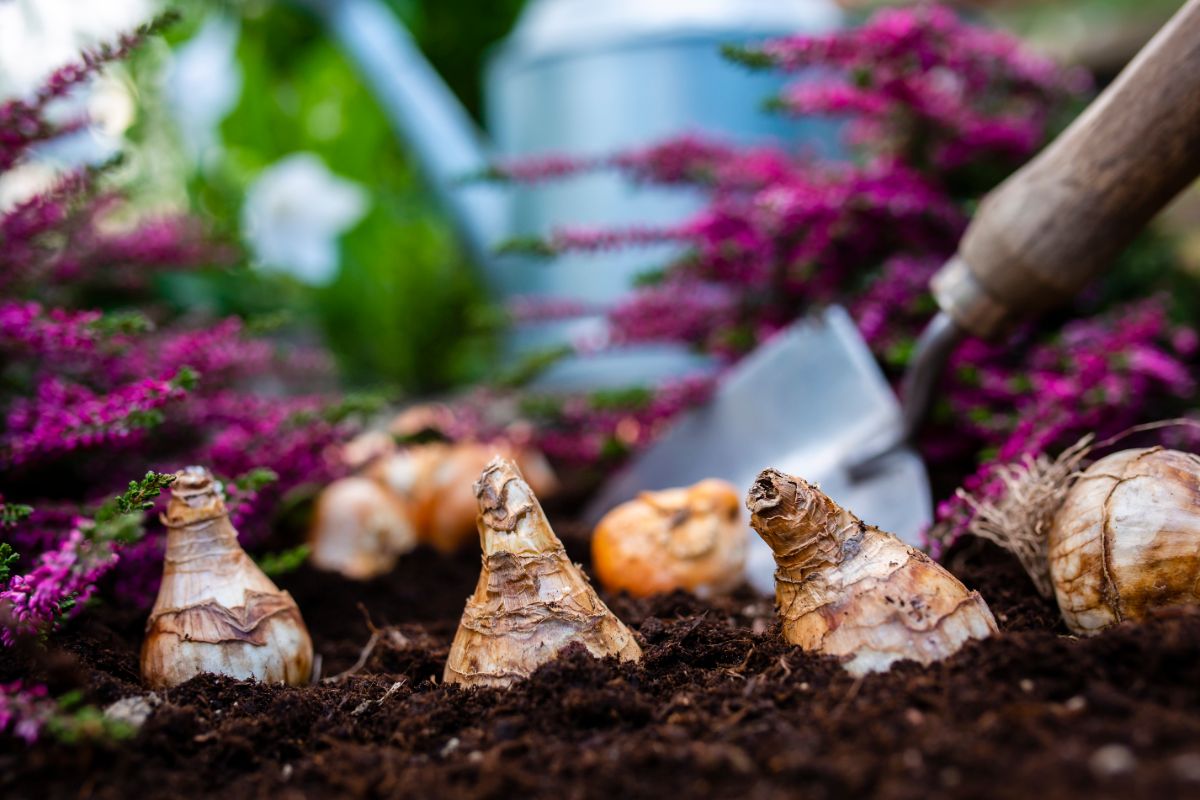
Fall gardens are a great time to get creative with warmly colored flowers in purple, orange and yellow. Plants like chrysanthemums, nasturtiums and asters are wonderful choices for seasonal planting arrangements. While perennials that will survive the winter are great choices, autumn is also a great time to explore new ideas will short-season annuals too.
But if you’re into garden planning and looking to create a more permanent planting arrangement and garden beds, often the best time to do that is in the autumn.
Between spring garden prep and summer weeding, it can be difficult to find time to plan out future changes for your garden in the warmer months. But once garden activity begins to slow down in fall, you’ll often find you have a bit of breathing room to develop your garden designs. Autumn is a great time to explore new planting arrangements, add new specimens or even pull out a sketch pad to develop new garden bed layouts.
But it’s not just the quiet of fall that makes it a prime time for planting. The cooler temperatures make autumn ideal for planting spring-blooming bulbs and some perennial shrubs. Planting them at the correct time in autumn will ensure that new plants have some time before the frosts begin to develop roots and establish themselves before winter. In spring, you’ll already have a head start in your garden when autumn-sown bulbs, like crocuses, begin to bloom.
Top 21 flowers for fall planting
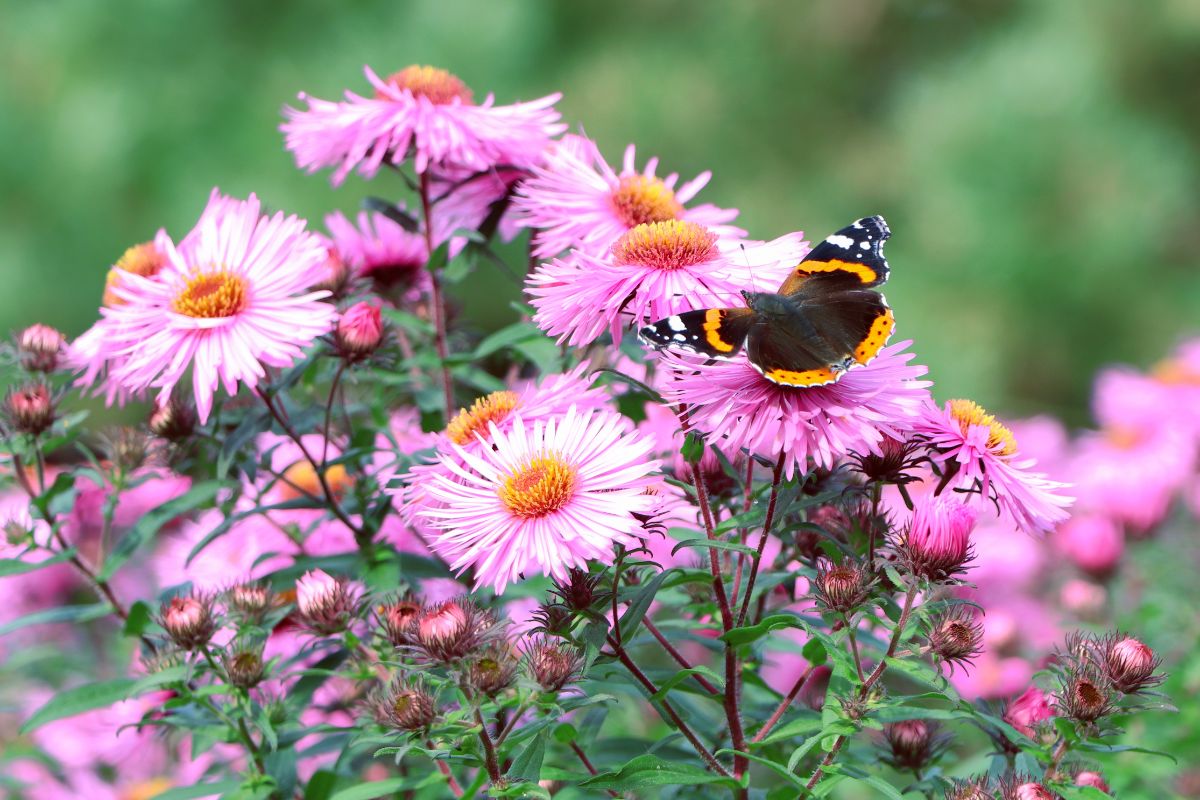
There are so many great flowers to plant in fall. Some are short-term annuals that produce a bounty of colorful flowers perfect for autumnal container planting. Others are spring-blooming bulbs that do best when sown in autumn. And still others are long-lasting perennials that are less likely to experience transplant shock when planted in cool, moist, autumn soil.
Below, we’ve compiled a list of some of our favorite flowers for fall planting. This is by no means an exhaustive list, but it’s a good place to start if you’re looking for a bit of inspiration.
1. Crocus
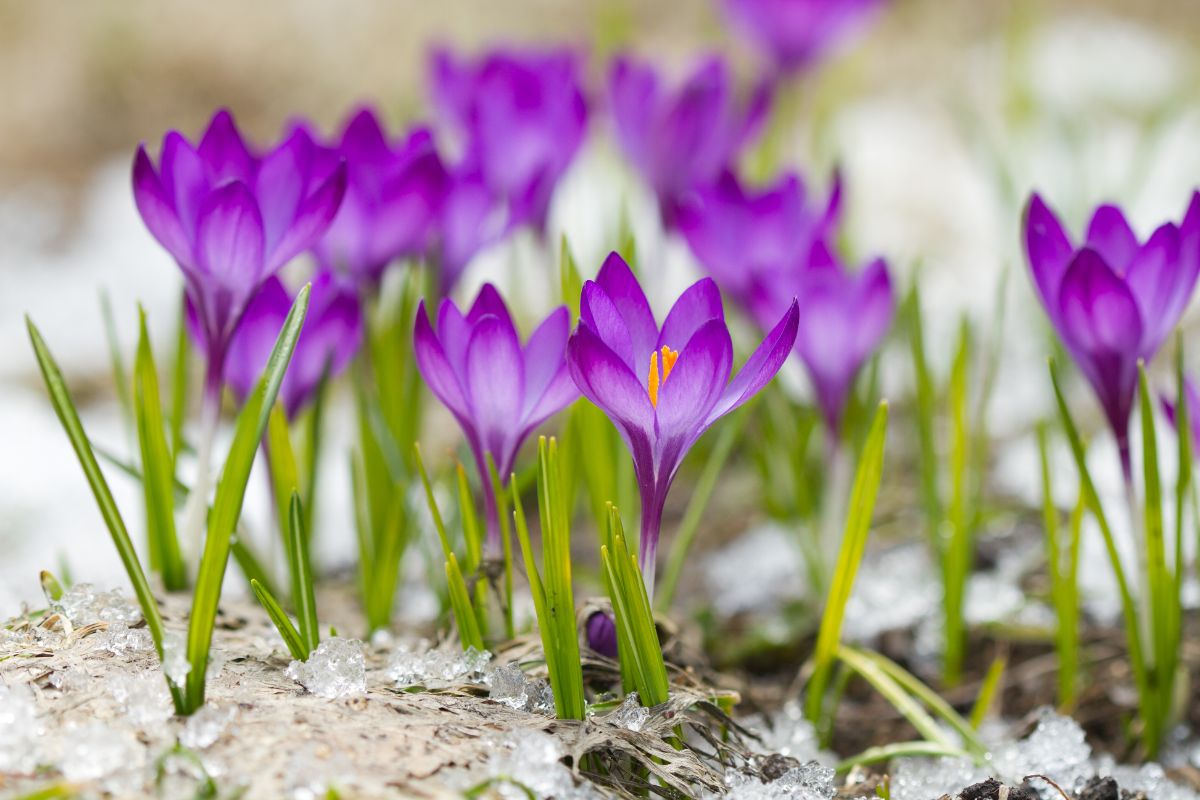
| Plant Type: | Crocus |
| How to Grow: | Spring blooming bulbs, some autumn blooming varieties available. Plant 6-8 weeks before first frost date. |
| Lighting: | Full sun to part shade |
| Water: | Moderate |
| Minimum Grow Zone: | Zone 3 (most varieties) |
One of the first flowers to bloom after winter, crocuses look like springtime. Coming in a range of colors, including yellow, white, blue, orange and purple, crocuses feature charming, cup-shaped flowers on short stems.
Super easy to grow, crocuses are some of the most popular bulbs to plant in autumn. They can tolerate full sun to partial shade and are ideally planted approximately 6 to 8 weeks before hard frost begins.
Because crocuses are rather small plants, for more distinct displays, try clumping bulbs together in groups of 3 to 9 plants per planting hole. This will make colors show better in your landscape.
For a particularly fun twist, try planting saffron or autumn crocus (Crocus sativus). Cultivated since ancient Rome, these crocuses are actually the source of the spice saffron, which is used in dishes like paella. Saffron comes from the red stigmas of this crocus variety and can be harvested and dried for culinary use.
2. Tulips
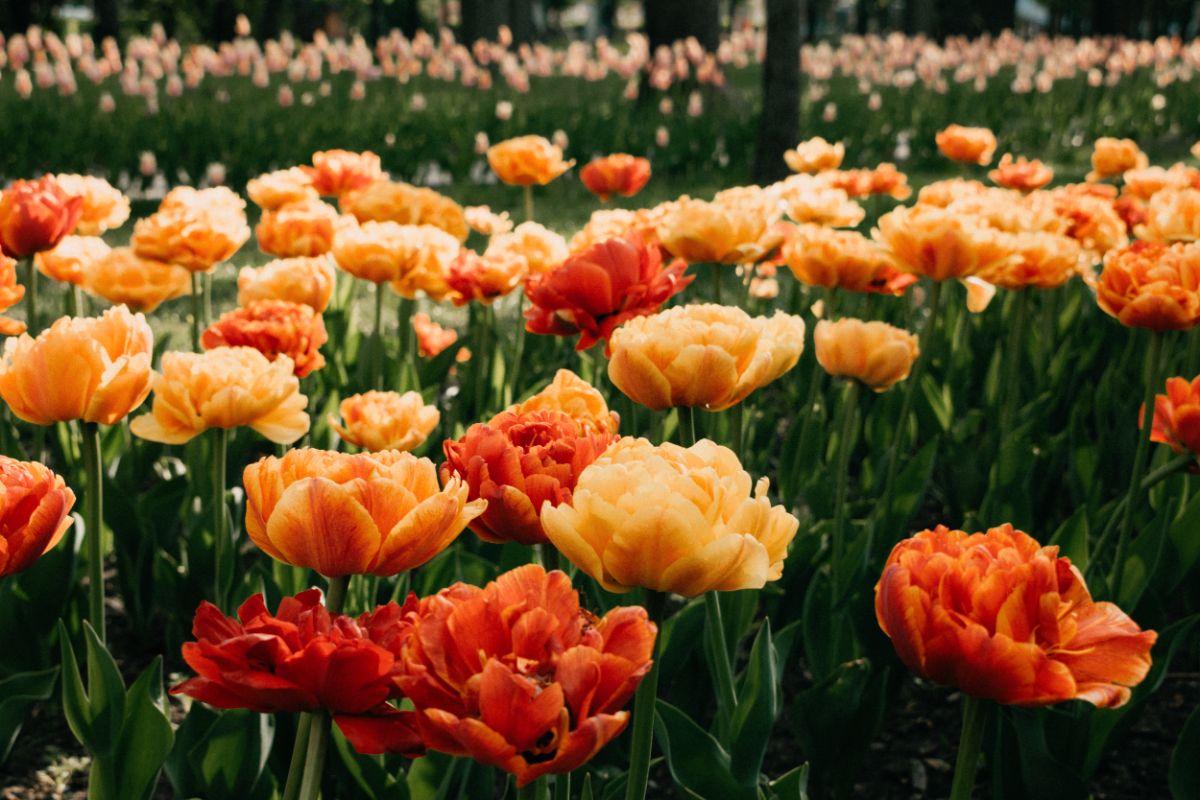
| Plant Type: | Tulips |
| How to Grow: | Spring blooming bulbs. Plant 6-8 weeks before first frost date. |
| Lighting: | Full sun |
| Water: | Low to moderate |
| Minimum Grow Zone: | Zone 3 |
Another wildly popular spring-blooming bulb, tulips are best planted in autumn when soil has cooled off after the summer heat. For most areas, the best time to plant tulips is in September or October, but check the grower’s instructions and plant according to your specific growing region.
Tulips are some of the most colorful flowers around, with bright red, pink, yellow, orange or even black blooms. Flowers can come in a range of shapes too, including single and double-bloom flowers. If you’re a fan of crafting homemade cut flower arrangements, tulips will give you lots of color to work with too.
Although often considered to be perennials, tulips may not come back year after year in certain areas. To ensure your tulips do regrow, make sure you plant them in a well-draining, sunny location and sow bulbs 4 to 6” deep. It can also help to cut back foliage after your plants bloom to encourage them to conserve energy and be sure to apply fertilizer once a year in autumn to give your plants a quick nutrient boost.
3. Hyacinth
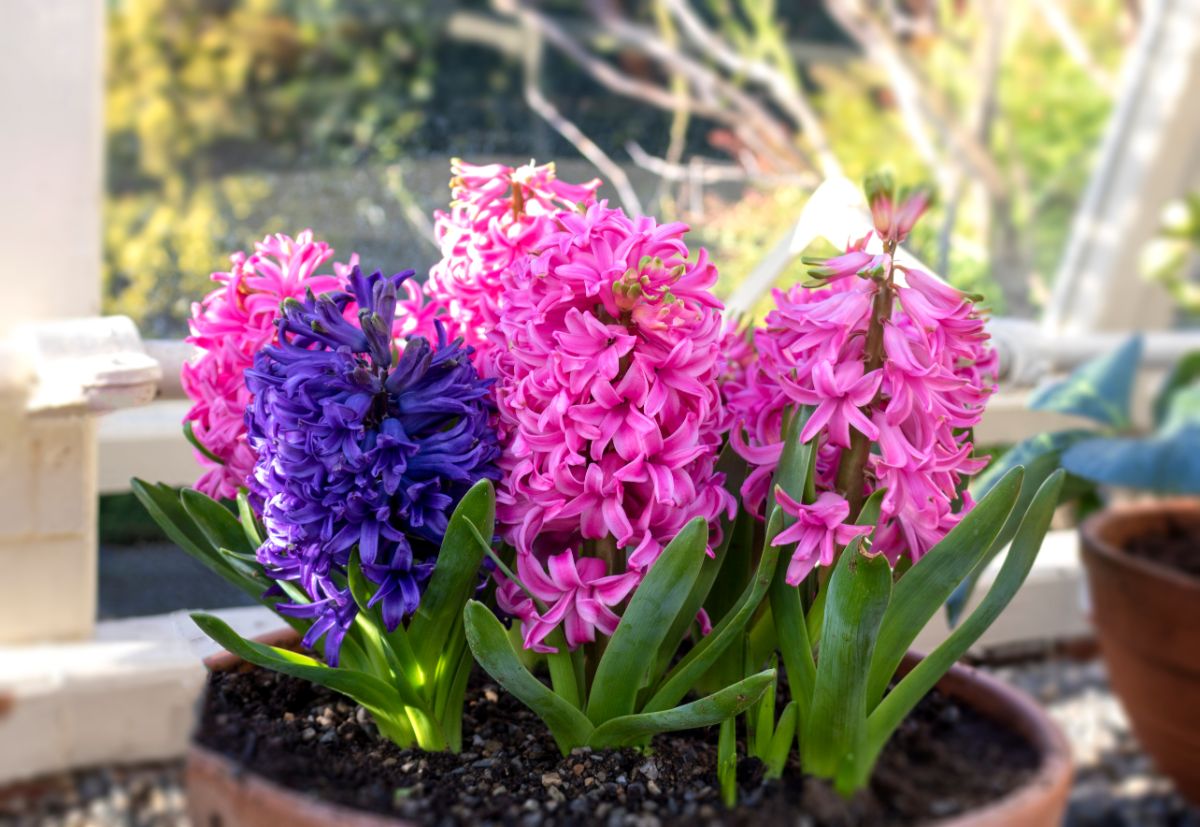
| Plant Type: | Hyacinth |
| How to Grow: | Spring blooming bulbs. Plant after first frost, before ground freezes. |
| Lighting: | Full sun |
| Water: | Moderate |
| Minimum Grow Zone: | Zone 4 |
If you love strongly fragranced flowers, plant some hyacinth bulbs. These highly perfumed flowers have a very recognizable sweet floral scent and can add a lovely touch when planted around a front door or in window boxes.
Best planted in mid- to late fall, hyacinth do well in full sun to part shade locations. For lots of contrast in your spring garden, try interplanting hyacinth with daffodils bulbs.
In spring, expect these beauties to bloom a single, bright-colored flower per stalk. Flowers are usually in pink, purple or white; however, you can find apricot, blue and red varieties too.
4. Daffodils
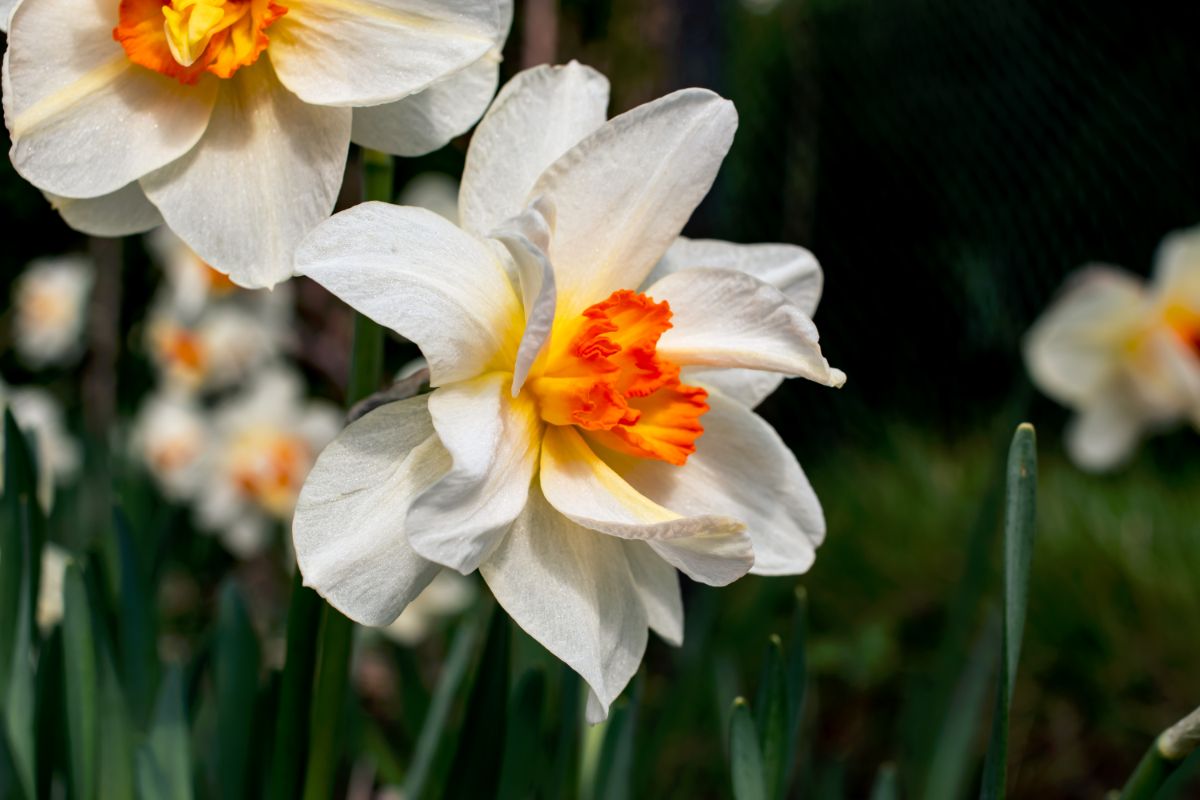
| Plant Type: | Daffodils |
| How to Grow: | Spring blooming bulbs. Plant 2-4 weeks before first frost date. |
| Lighting: | Full sun |
| Water: | Moderate |
| Minimum Grow Zone: | Zone 3 |
Jonquils, paperwhites and daffodils are all gorgeous, cheery flowers that belong to the Narcissus family. All growing from bulbs that are sown in autumn, these plants are all easy-to-care for and bloom reliably in spring with little effort.
While daffodils are often found in yellow, members of the Narcissus family can come in white and orange too. If you prefer smaller blooms, opt for paperwhites which generally produce more delicate flowers.
You’ll want to aim to have your Narcissus bulbs in the ground sometime between September and November. This will ensure that your plants have plenty of time to establish themselves and store energy up for spring blooming. In general, daffodils and other members of this family tend to flower in late winter to early spring, approximately around Easter time.
Great for cut flower arrangements, try planting daffodil bulbs in clusters to maximize their impact in your garden.
5. Alliums
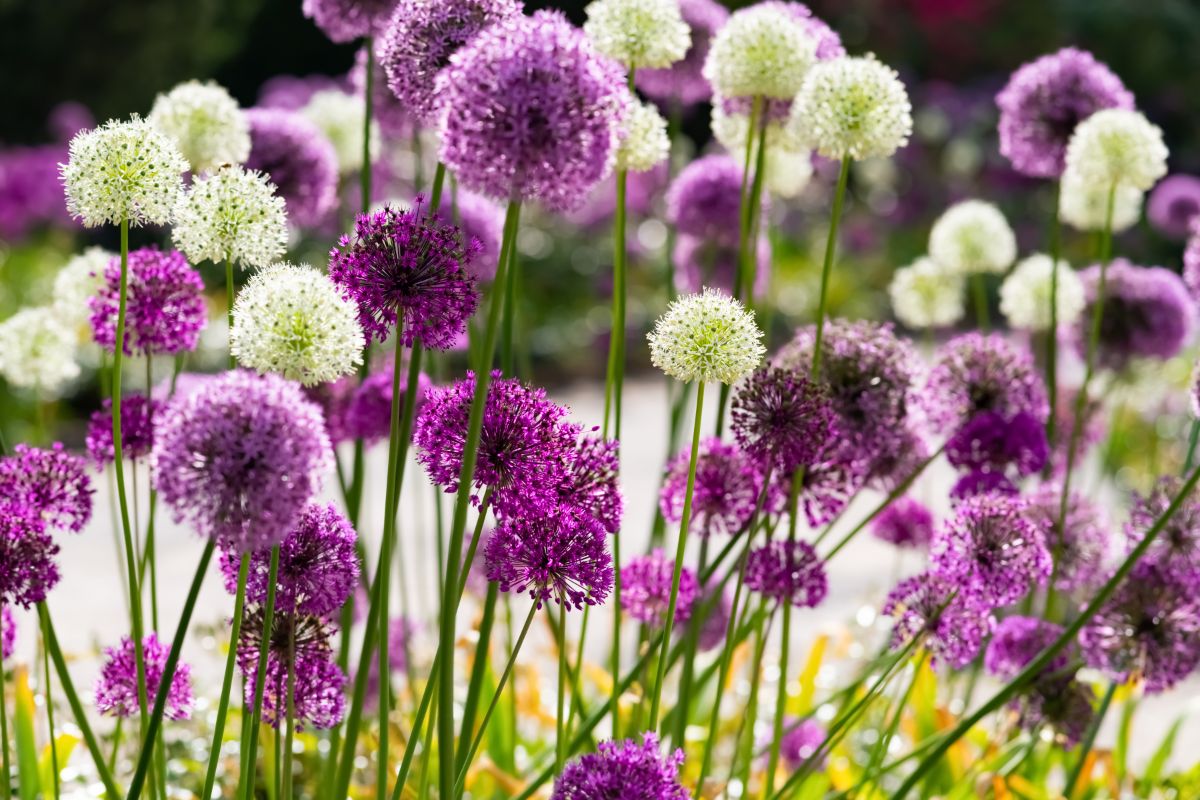
| Plant Type: | Alliums |
| How to Grow: | Spring blooming bulbs. Plant in mid- to late autumn, before ground freezes. |
| Lighting: | Full sun to part shade |
| Water: | Moderate |
| Minimum Grow Zone: | Zone 3 |
If you love unusual flowers and creative landscape designs, try out some alliums. These oddball plants feature globe-shaped flowers atop long slender stems and lend an architectural element to garden beds and container arrangements.
Another fall-planted bulb, alliums bloom in early summer and produce long-lasting flowers that can stay vibrant for up to 3 weeks. Flowers are generally purple, but they come in white, yellow, pink and blue too.
Most commonly, you’ll find tall allium plants, but some varieties of alliums have a lower growth habit and are better for planting in the front of garden beds.
As close relatives of sulfur-rich plants, like garlic and onions, ornamental alliums are naturally quite pest resistant and can also repel insects from other plants. So, for natural pest control, try planting your allium bulbs near other ornamentals that tend to attract pests, like aphids. A great companion plant pairing is planting roses near your alliums to repulse destructive pests.
6. Peonies
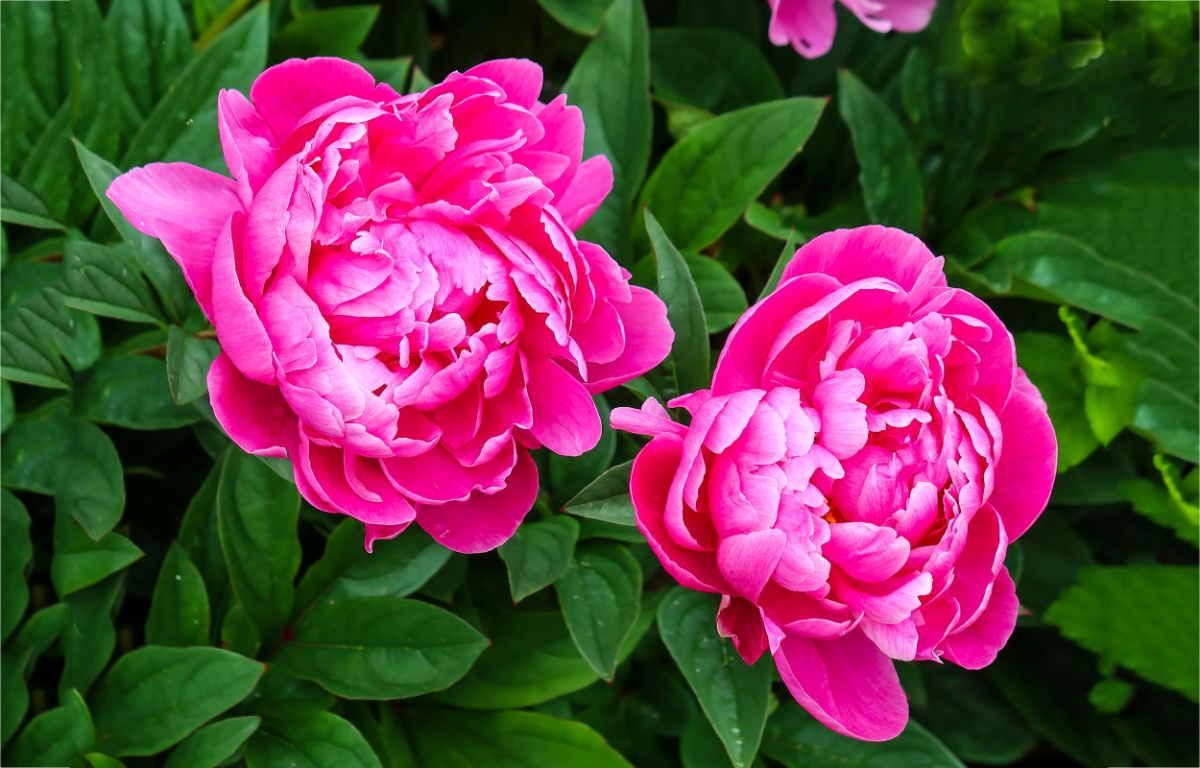
| Plant Type: | Peonies |
| How to Grow: | Nursery starts, Bulbs. Plant bulbs 6 weeks before first frost date. |
| Lighting: | Full sun |
| Water: | Moderate |
| Minimum Grow Zone: | Zone 3 |
Peonies boast big, beautiful flowers in pink, red, orange, yellow and white. Those flowers can come in single or double blooms and are known for their sweet floral fragrance.
Growing from tubers, rather than bulbs, peonies should be planted in autumn, usually in September or October for most growing regions. Once properly established, your plants should bloom in April to June. Cut flowers work very well in bouquets and tabletop arrangements.
Peonies do need a bit more care than other plants to grow properly. In particular, they can benefit from staking or growing in cages, as they can tend to spread and droop a bit in certain growing conditions. Staking and regular pruning can also help prevent powdery mildew, which is a common disease in peonies.
7. Lilies
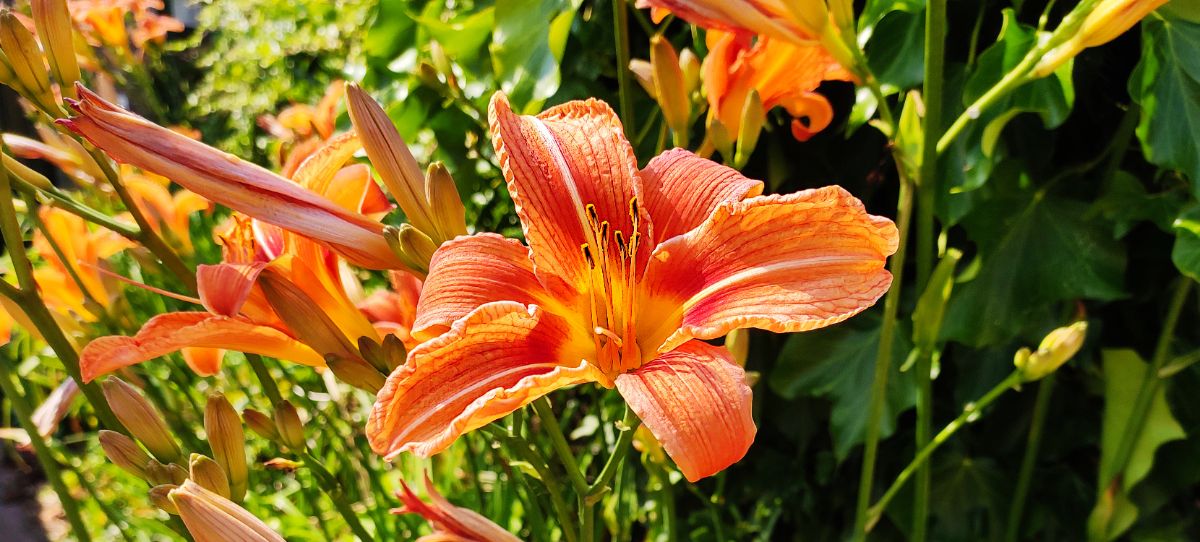
| Plant Type: | Lilies |
| How to Grow: | Nursery starts, Bulbs. Plant bulbs 4 weeks before first frost date. |
| Lighting: | Depends on variety |
| Water: | Moderate |
| Minimum Grow Zone: | Depends on variety |
There are over 90 different species of lilies in the world, including popular landscaping varieties like Asiatic lilies, Easter lilies, tiger lilies and daylilies. Adaptable to a range of conditions, varieties like daylilies can even grow in shady yards.
Known for their bold summertime blooms, lily bulbs are usually planted in autumn, about 4 weeks before your first frost date. Timing is important, because you’ll want to give your lilies enough time to sprout some roots before that first hard freeze.
Generally low maintenance plants, lily bulbs spread and multiply quite rapidly. As a result, you should plan on dividing your lilies every 3 to 4 years to ensure they have adequate growing room.
If you have outdoor cats, keep in mind that lilies are very toxic to felines, so they may not be the best choice if your kitty likes to munch on your garden plants.
8. Bluebells

| Plant Type: | Bluebells |
| How to Grow: | Nursery starts, Bulbs. Plant bulbs in autumn, before ground freezes. |
| Lighting: | Full to part shade |
| Water: | Moderate |
| Minimum Grow Zone: | Zone 4 |
Lesser known than peonies, but no less stunning, bluebells are delicate little flowers. Often blue in color, these bell-shaped blooms grow in clusters that cascade from a single, slender stem.
There are 6 common varieties of bluebell plants, including types with solid blue flowers and other varieties that change color. Virginia bluebells are prized for their chameleon-like properties as they produce pink buds that mature into blue flowers.
Bulbs should be planted in mid-fall and flowers will appear in March to May, depending on your growing location. Aim to plant your bluebells 4 to 8” deep and place them in an area that receives full to partial shade.
9. Grape hyacinth
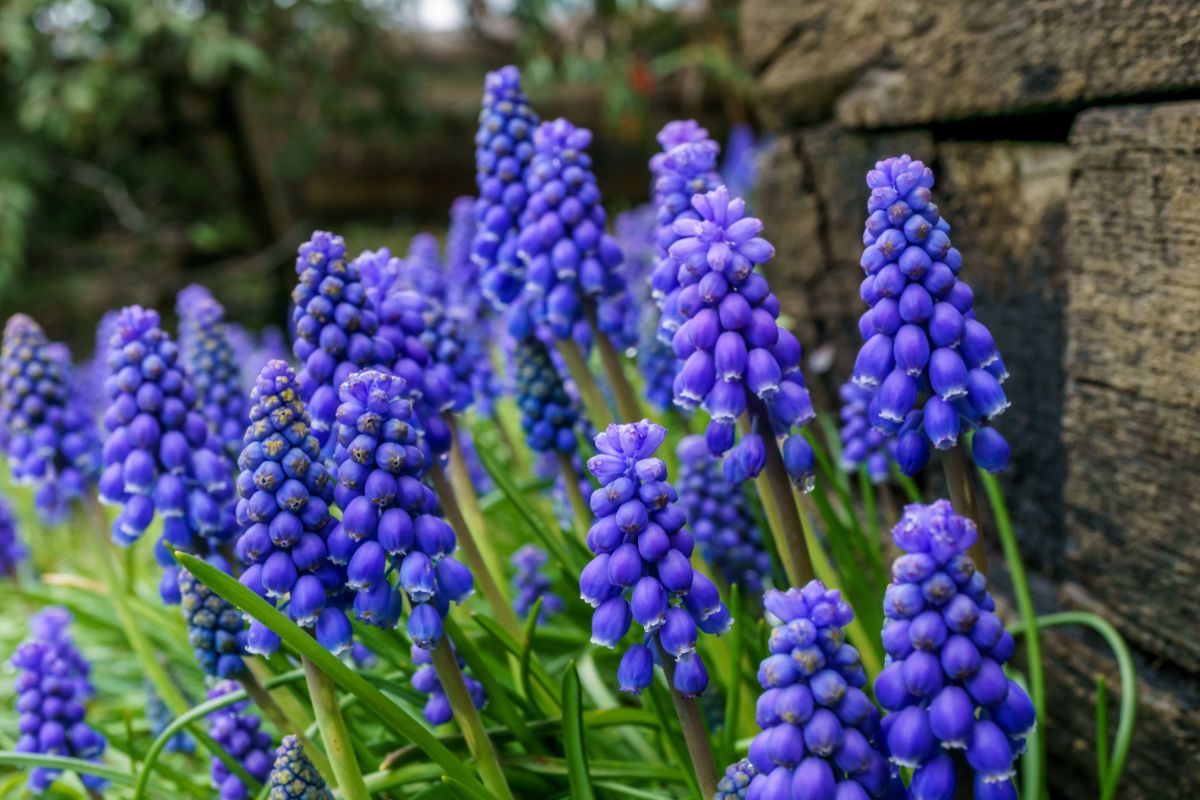
| Plant Type: | Grape Hyacinth |
| How to Grow: | Spring blooming bulbs. Plant in mid- to late autumn, before ground freezes. |
| Lighting: | Full sun to part shade |
| Water: | Moderate |
| Minimum Grow Zone: | Zone 3 |
An early blooming spring flower, grape hyacinth bulbs are planted in the fall and should be buried about 3 to 4” deep. Adaptable to a range of lighting conditions, grape hyacinth can grow in full sun to partial shade.
Despite its name, grape hyacinth is not closely related to common garden hyacinth and produces more delicate flowers that appear almost grape-like in their clustered forms. Growing low to the ground, grape hyacinth makes an unusual, colorful ground covering too.
Flowers are long lasting and can linger for up to 3 weeks after sprouting. Blooming from April to May, try planting a cluster of grape hyacinth together to add lots of purple to your garden.
10. Lily of the Valley
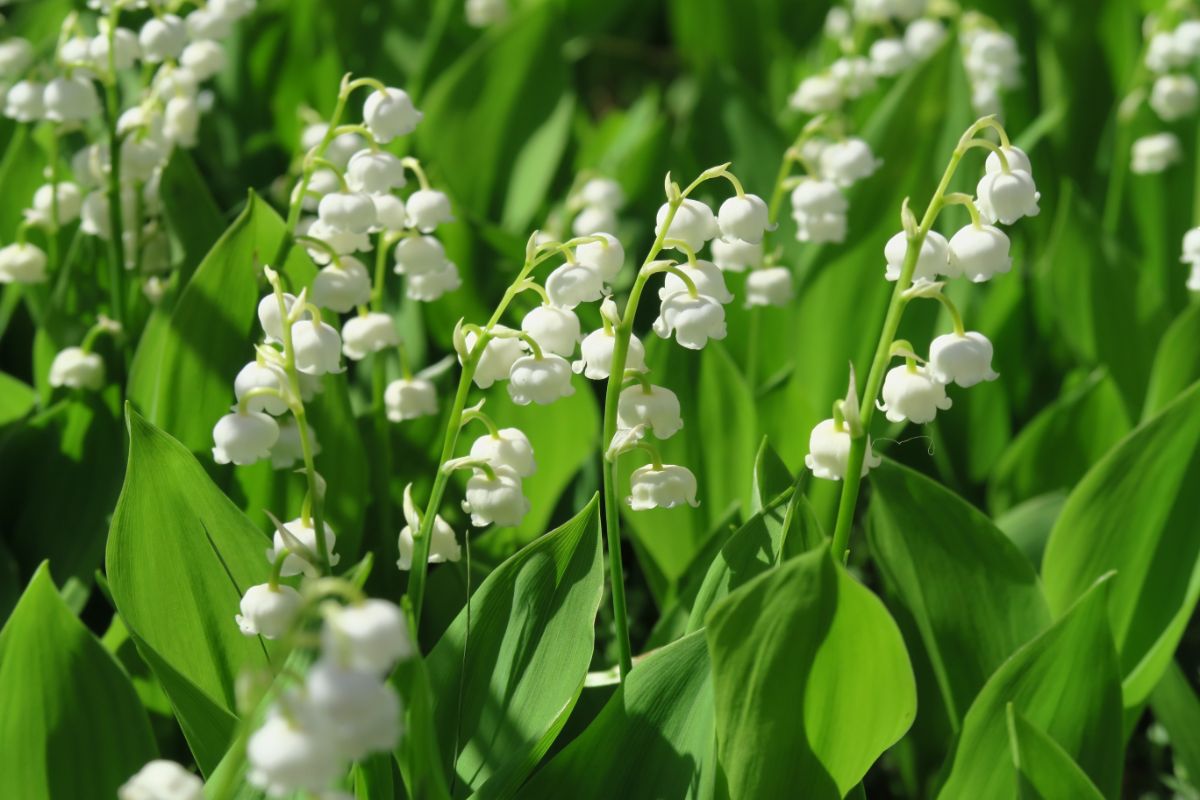
| Plant Type: | Lily of the Valley |
| How to Grow: | Spring blooming bulbs. Plant in mid- to late autumn, before ground freezes. |
| Lighting: | Part sun to full shade |
| Water: | Low to moderate, semi-drought tolerant when established. |
| Minimum Grow Zone: | Zone 3 |
Low growing plants, lily of the valley are great choices for a different sort of ground cover as they are keen to grow closely together in mats. However, unlike other groundcovers, they offer lots of pretty, white flowers that exude a strong, floral fragrance.
Native to Asia and North America, lily of the valley grows best in full to partial shade and is a great choice if you don’t have a sunny yard.
Plant bulbs in late fall, as cold temperatures are needed for proper growth. In spring, your bulbs will sprout an abundance of bell-shaped flowers that last several weeks before transitioning into colorful berries.
11. Snowdrops
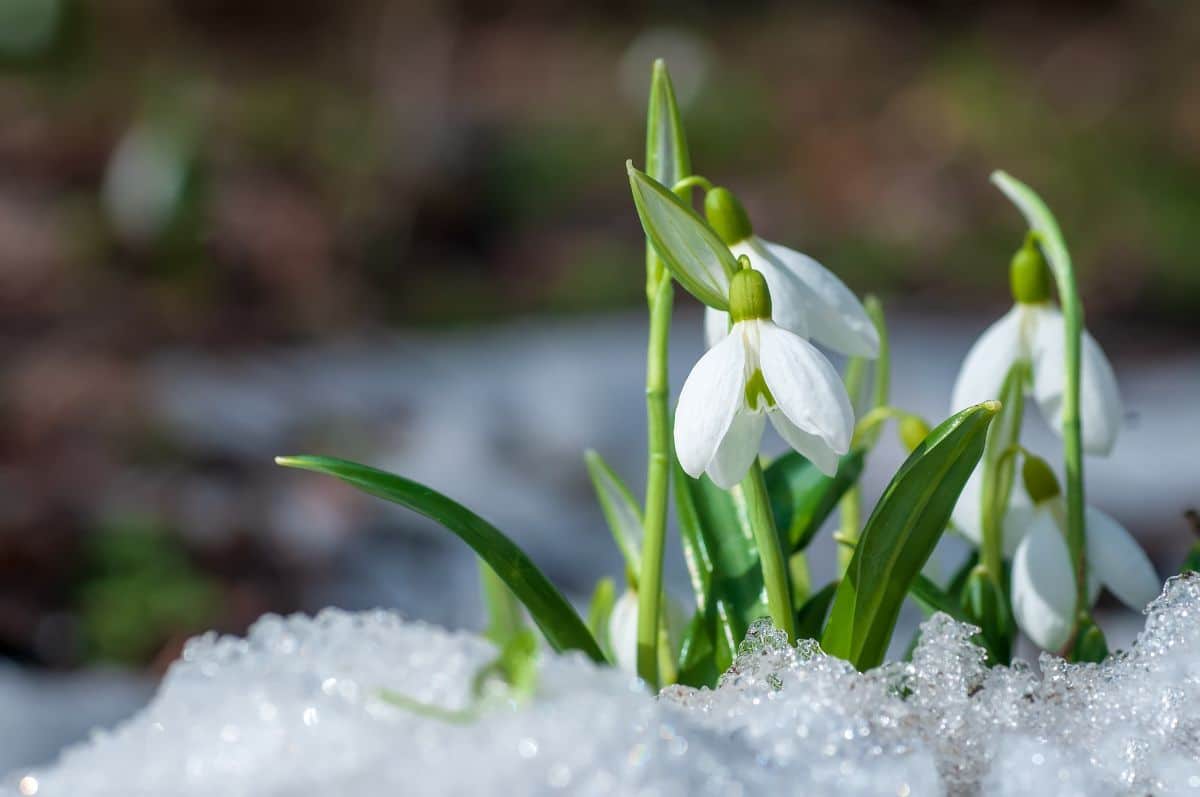
| Plant Type: | Snowdrops |
| How to Grow: | Spring blooming bulbs. Plant in early autumn. |
| Lighting: | Full sun |
| Water: | Moderate |
| Minimum Grow Zone: | Zone 3 |
If find yourself impatient for spring to come every year, plant some snowdrops. Often the first flowers to bloom in the spring, snowdrop can be seen as early as February and flowers can even pop up through the snow!
Because they are such early bloomers, snowdrops provide a much-needed source of nectar and pollen for any insects and pollinators that are active in the cooler months. This makes snowdrops one of the best plants to add to pollinator gardens.
Hardy to zone 2, snowdrops are native to Europe and the Middle East; however, they are very commonly planted in North American gardens too.
12. Anemones
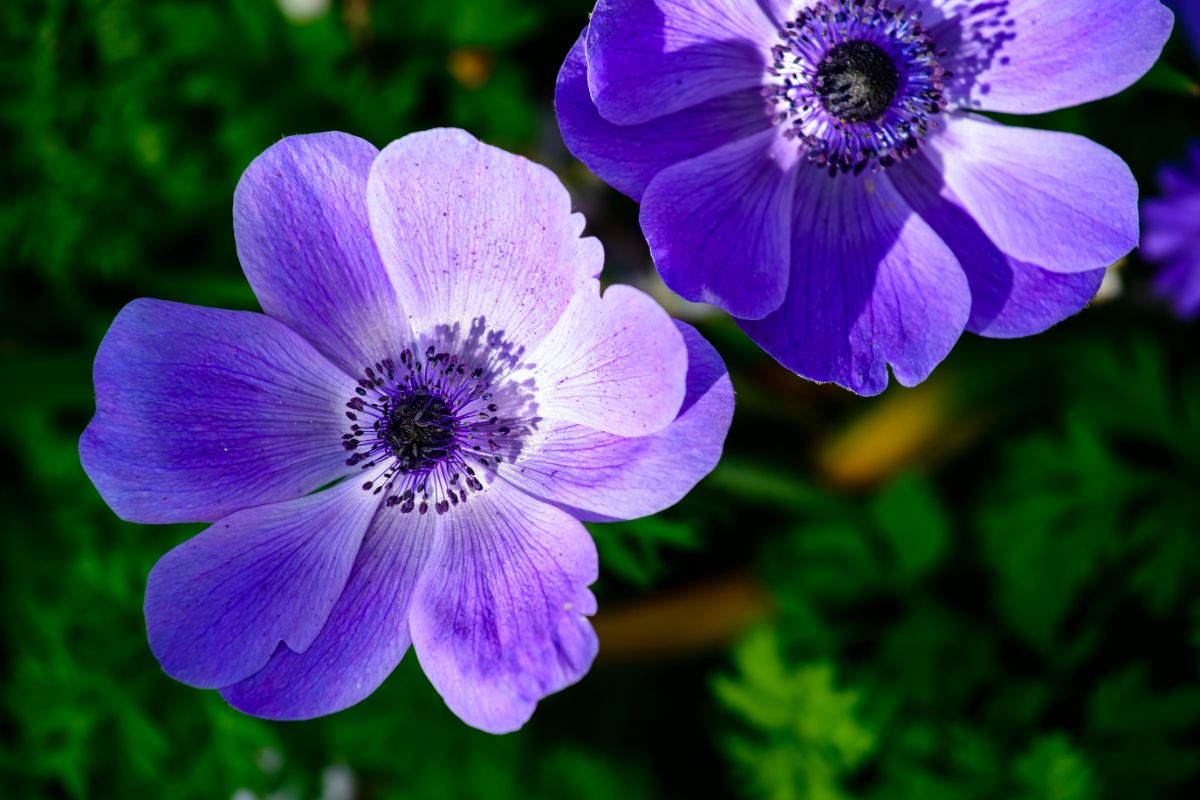
| Plant Type: | Anemones |
| How to Grow: | Spring blooming bulbs. Plant in mid- to late autumn, before ground freezes. |
| Lighting: | Depends on variety |
| Water: | Moderate |
| Minimum Grow Zone: | Zone 3 |
If you love the look of poppies or cosmos, you’ll love anemones. Anemones offer lacy leaves and petals in white, blue, red or yellow surrounding a highly contrasting dark center. Their delicate form and colorful blooms are sure to stun in any flower bed.
Blooming from spring until fall, try planting your anemone bulbs before October to guarantee spring flowers.
As perennials, anemones should come back year after year and can form wonderful groundcovers or borders in your yard. Plants can grow from 1 to 3’ tall and are able to adapt to full sun and partial shade too.
13. Fritillaria

| Plant Type: | Fritillaria |
| How to Grow: | Spring blooming bulbs. Plant in early autumn. |
| Lighting: | Full sun to part shade |
| Water: | Moderate |
| Minimum Grow Zone: | Zone 4 |
If you’re looking for a stunning plant that your neighbors are sure not to have, opt for fritillaria. These unusual plants may not be a common sight in most gardens, but that’s not their fault!
Flowers come in a range of colors and some even have highly patterned petals that appear to have an almost geometric design to them. These bell-shaped flowers appear in spring and can last for several weeks.
Members of the lily family, fritillaria are perennials and prefer well-drained soil and full to partial sun.
While there are many different types of fritillaria, two particularly popular varieties include Fritillaria meleagris and Fritillaria imperialis.
14. Mums
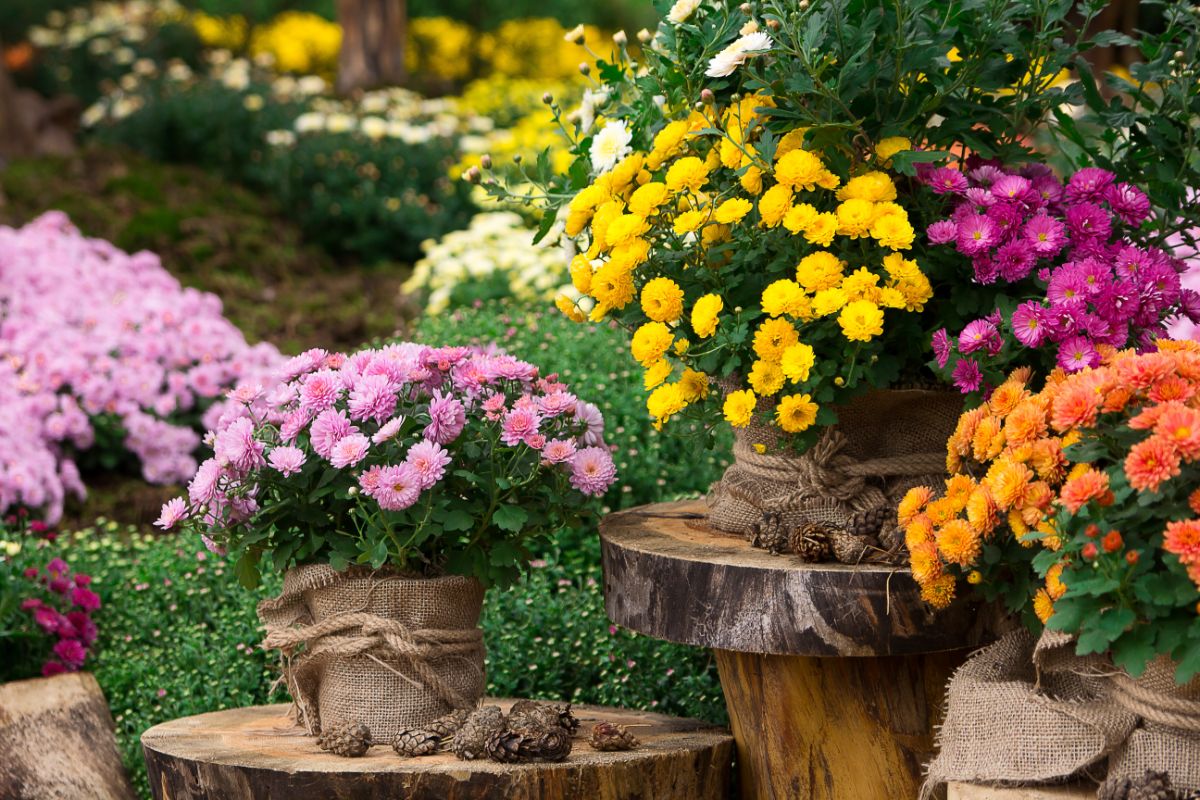
| Plant Type: | Mums |
| How to Grow: | Nursery starts |
| Lighting: | Full sun |
| Water: | Moderate |
| Minimum Grow Zone: | Depends on variety. Most common varieties are hardy to zone 7. |
No fall garden is complete without mums. Also known as chrysanthemums, mums are a staple of autumn flower beds and container gardens where their colorful blooms bring an easy boost of color.
Native to Asia and northern Europe, mums are easy to care for plants. Just provide them with consistent watering and full sun to part shade and they should be good to go.
Most commonly, mums are sold as mature plants that are ready for potting up in containers or planting in your garden. These mums are generally kept as annuals and die back in winter; however, you can opt for hardy mums instead which grow as perennials in zone 5 and above.
15. Nasturtium
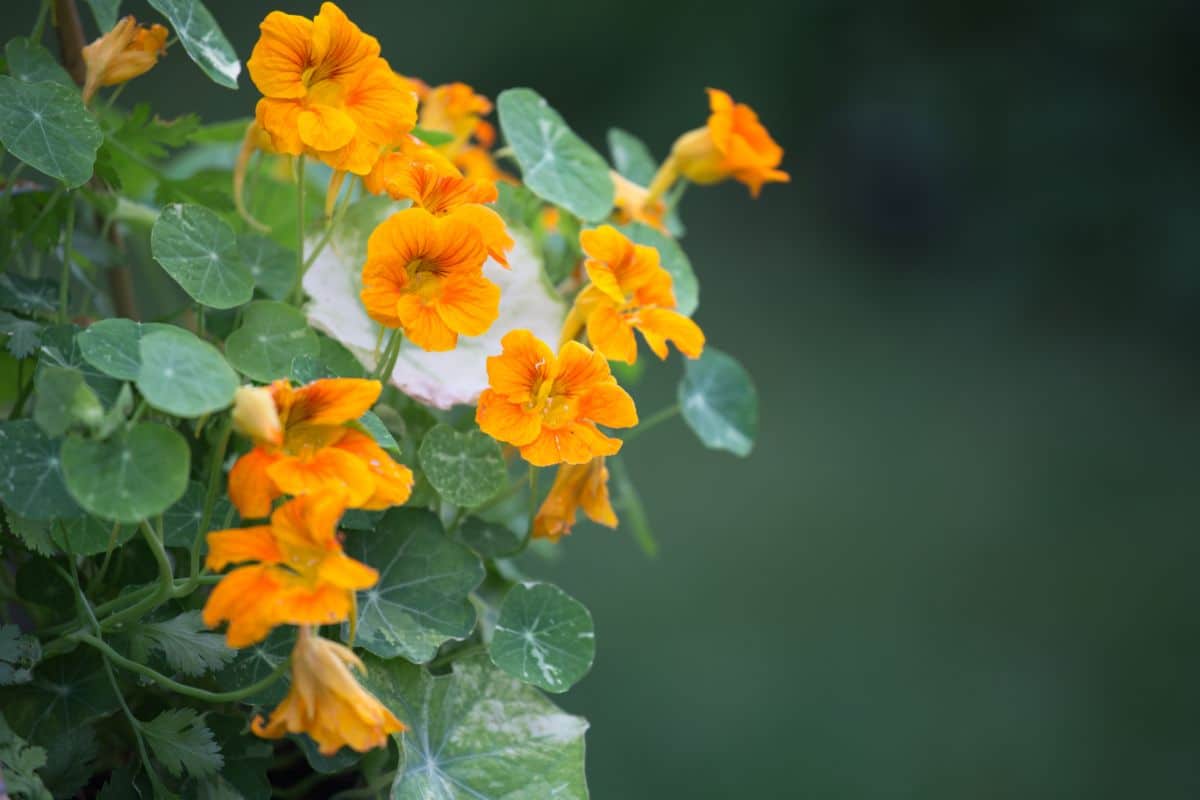
| Plant Type: | Nasturtium |
| How to Grow: | Nursery starts, Seeds. Start seeds in July for fall flowers. |
| Lighting: | Full sun |
| Water: | Moderate |
| Minimum Grow Zone: | Annual |
Nasturtium come in both mounding and trailing varieties and boast fall-toned flowers in warm yellows and oranges. Excellent in in-ground beds, nasturtium really shine in container planters where trailing varieties’ long tendrils can be allowed to cascade naturally.
Easy to care for, nasturtium can be grown from nursery starts, but they are simple to grow from seeds too. If you want to use nasturtium in your autumnal arrangements, sow seeds in late summer for fall flowers. These quick growers take about 4 to 6 weeks to begin producing flowers when started from seed.
And if nasturtiums’ pretty flowers weren’t enough reason to plant them, all parts of these plants are edible and their flowers make excellent salad toppers. Nasturtiums taste a bit peppery in flavor, which can add an interesting touch to any dish.
16. Pansies
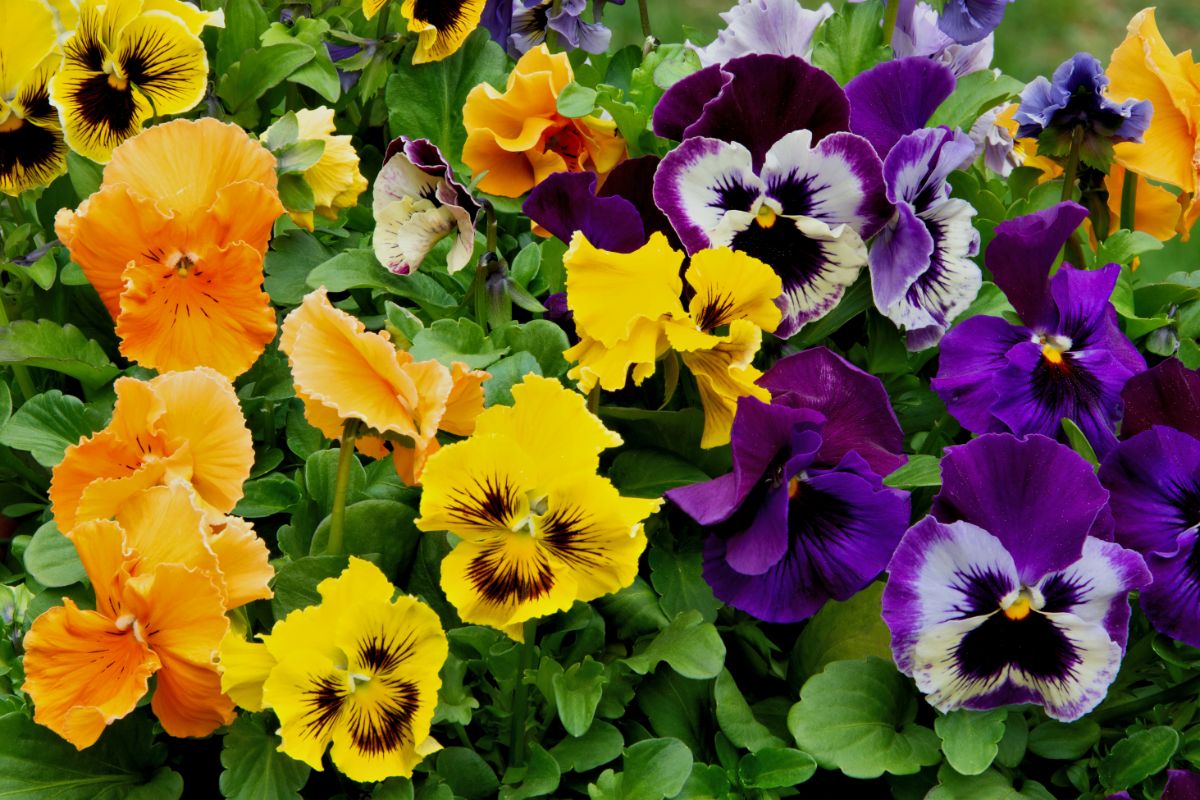
| Plant Type: | Pansies |
| How to Grow: | Nursery starts, Seeds. |
| Lighting: | Full sun to part shade |
| Water: | Moderate |
| Minimum Grow Zone: | Zone 6 |
Pansies are cheery little flowers that grow well as border plants or in container garden. For fall planting arrangements, you can’t get more autumnal than pairing some pansies with mums and nasturtium.
Despite their delicate look, pansies are surprisingly cold hardy and can even survive short periods of sub-freezing temperatures, although they may lose a bloom or two. If flowers get damaged by frost, simply snip them off and your plants will likely recover.
Pansies come in lots of colors and are often sold as starts at nurseries from spring to fall. If you choose instead to grow your plants from seed, keep in mind that it can take up to 12 weeks for them to flower, so plan your planting accordingly.
17. Goldenrod
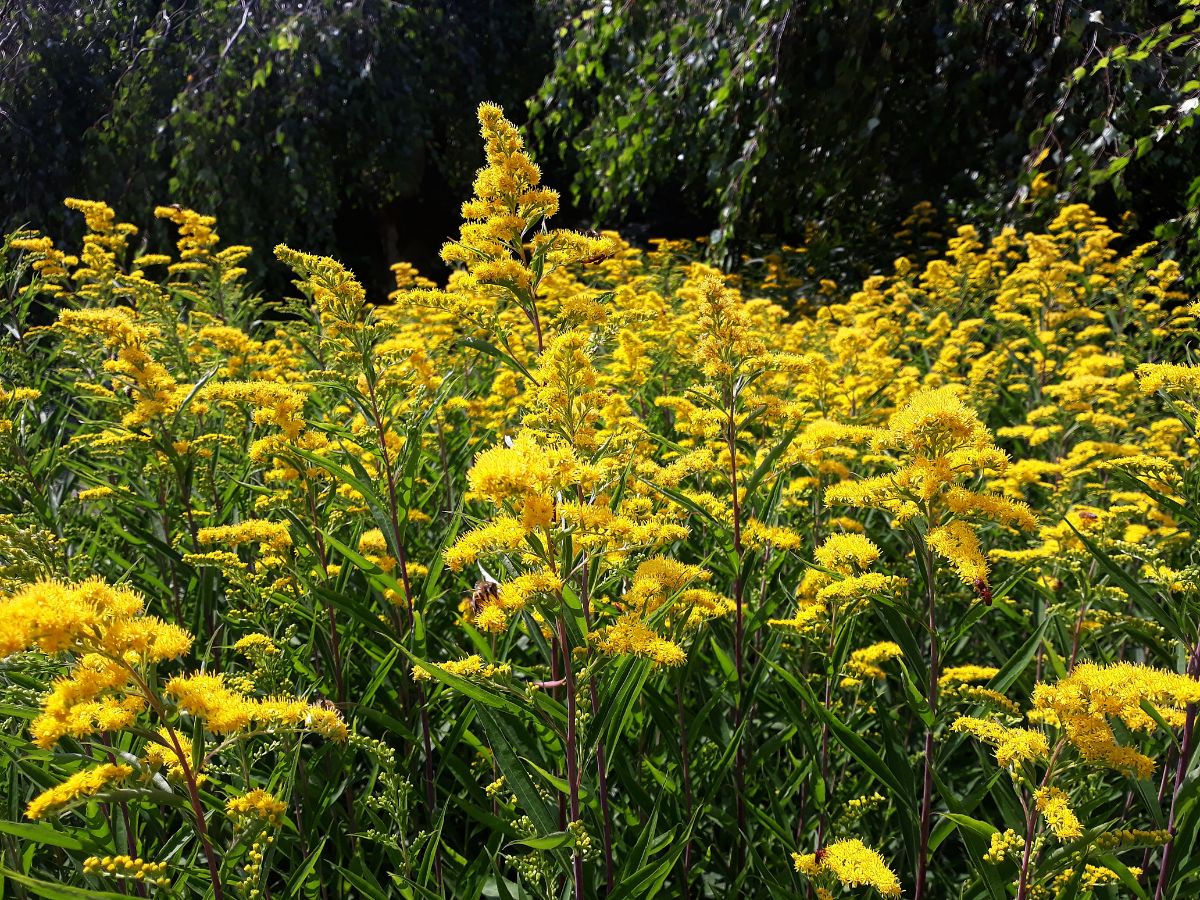
| Plant Type: | Goldenrod |
| How to Grow: | Nursery starts |
| Lighting: | Full sun to part shade |
| Water: | Low to moderate, semi-drought tolerant when established. |
| Minimum Grow Zone: | Zone 2 |
Goldenrod is a gorgeous yellow flowering plant that is native to North America. Frequently confused with ragweed, a common allergen, goldenrod is often wrongly blamed for seasonal allergies.
In the autumn garden, goldenrod adds a warm touch of color and is also a valuable food source for late-foraging pollinators who need its nectar and pollen to store up energy for migration and hibernation.
There are over 100 recognized species of goldenrod and they vary in size; however most varieties grow to about 3 to 4’ tall. Very drought tolerant, these easy-going perennials can grow in full sun to part shade.
18. Asters
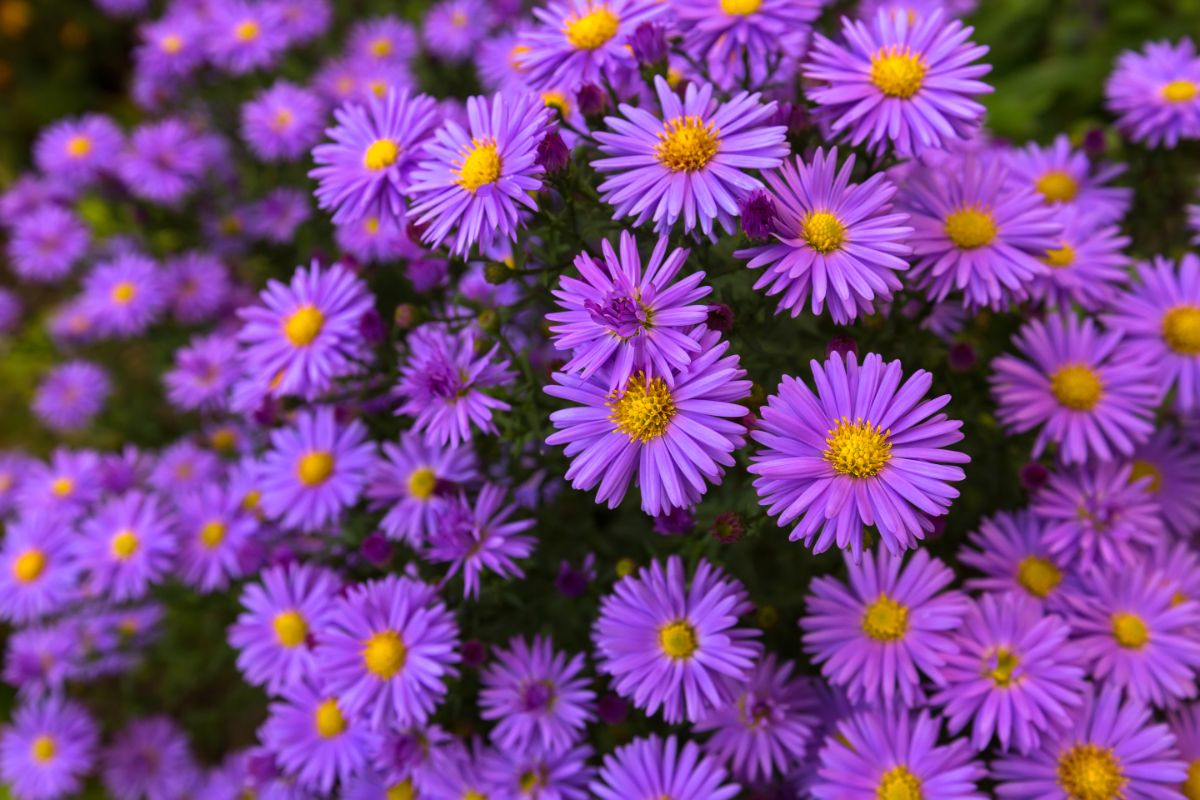
| Plant Type: | Asters |
| How to Grow: | Nursery starts |
| Lighting: | Full sun |
| Water: | Moderate |
| Minimum Grow Zone: | Zone 3 |
There are over 170 types of asters, ranging in size from 1 to 6’ tall. With daisy-like blooms, asters come in a multitude of colors, though they are most commonly spotted in purple. Great for in-ground and container plantings, asters look particularly thrilling when paired with goldenrod’s contrasting flowers.
One of the best autumn bloomers for pollinators, asters are bee favorites and are sure to have your garden buzzing with lots of activity.
Simply plant your asters in full sun to part shade and provide them with rich, well-draining soil and consistent watering. These plants can be sensitive to both too much and too little water and can sometimes struggle with root rot in waterlogged conditions.
19. Hydrangea
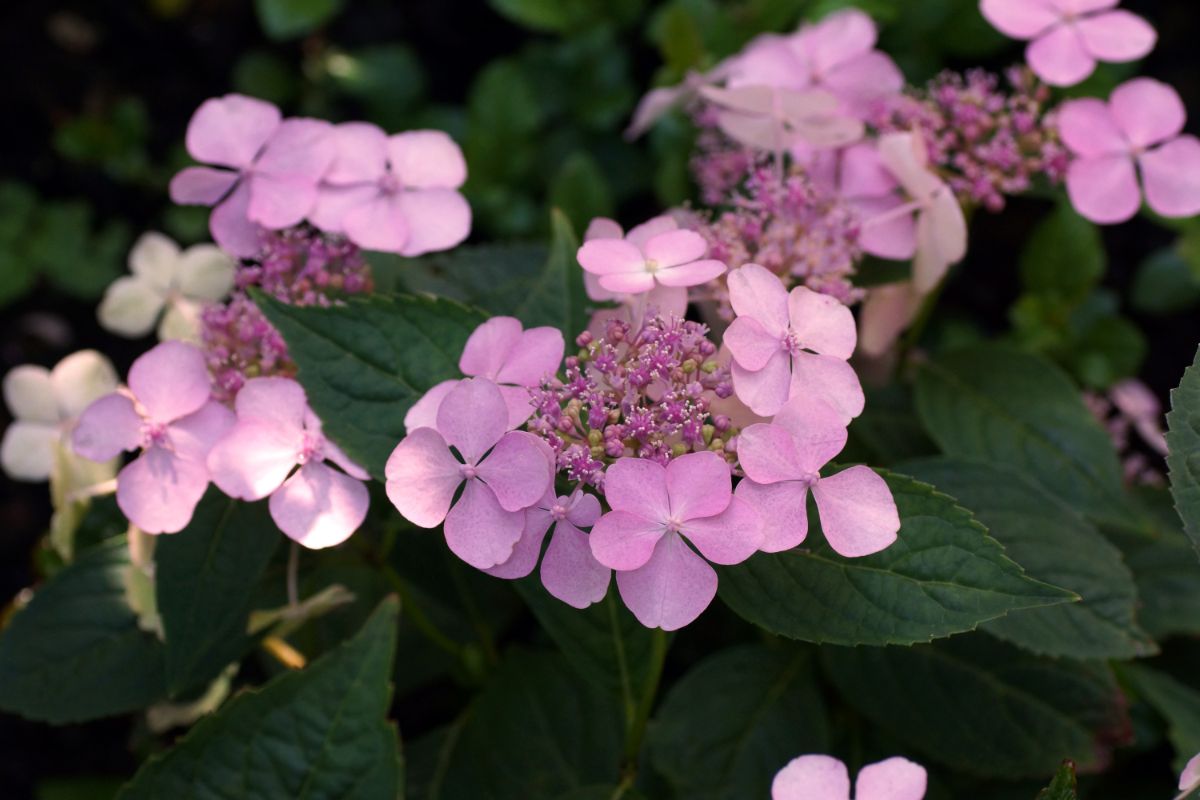
| Plant Type: | Hydrangea |
| How to Grow: | Nursery starts |
| Lighting: | Full sun to part shade; afternoon shade is best. |
| Water: | Moderate |
| Minimum Grow Zone: | Zone 3 |
There are at least 23 different varieties of hydrangea and different types have varying flower sizes and shapes. Some hydrangeas are even able to climb walls and fences for a really unique look.
While hydrangeas are quite hardy shrubs, they are best planted in fall, as the cool weather won’t stress delicate transplants. Just be sure to get your hydrangeas planted early enough that they can establish themselves in your garden beds before cold temperatures really set in.
With long-blooming flowers that appear in late summer to early fall, hydrangea blooms are great in cut flower arrangements and even dry well for preserved displays.
For an interesting science experiment of sorts, hydrangeas colors can be altered by changing your soil’s pH. Acidic soil produces blue flowers, while alkaline soil creates pink blooms.
20. Viburnum
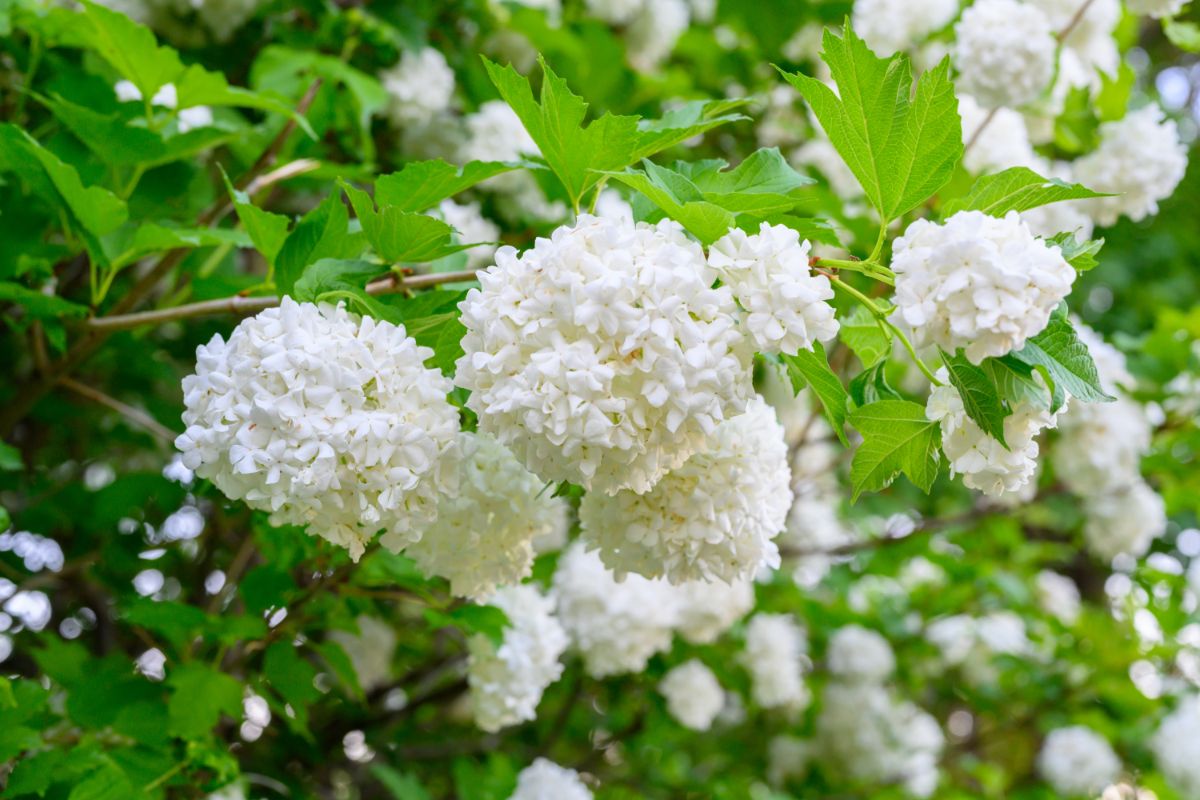
| Plant Type: | Viburnum |
| How to Grow: | Nursery starts |
| Lighting: | Full sun to part shade; some prefer full shade. |
| Water: | Moderate |
| Minimum Grow Zone: | Zone 2 |
There are over 150 different types of viburnum, most of which are native to North America. Some types are highly scented, while others, like the snowball bush viburnum, create large globular clusters of white flowers.
Blooming in early spring through June, viburnums are some of the best sources of nectar and pollen for early-emerging pollinators.
Most often planted in autumn, viburnums can adapt to sun or shade; however, full sun encourages plants to produce more flowers and ornamental berries.
21. Lilacs
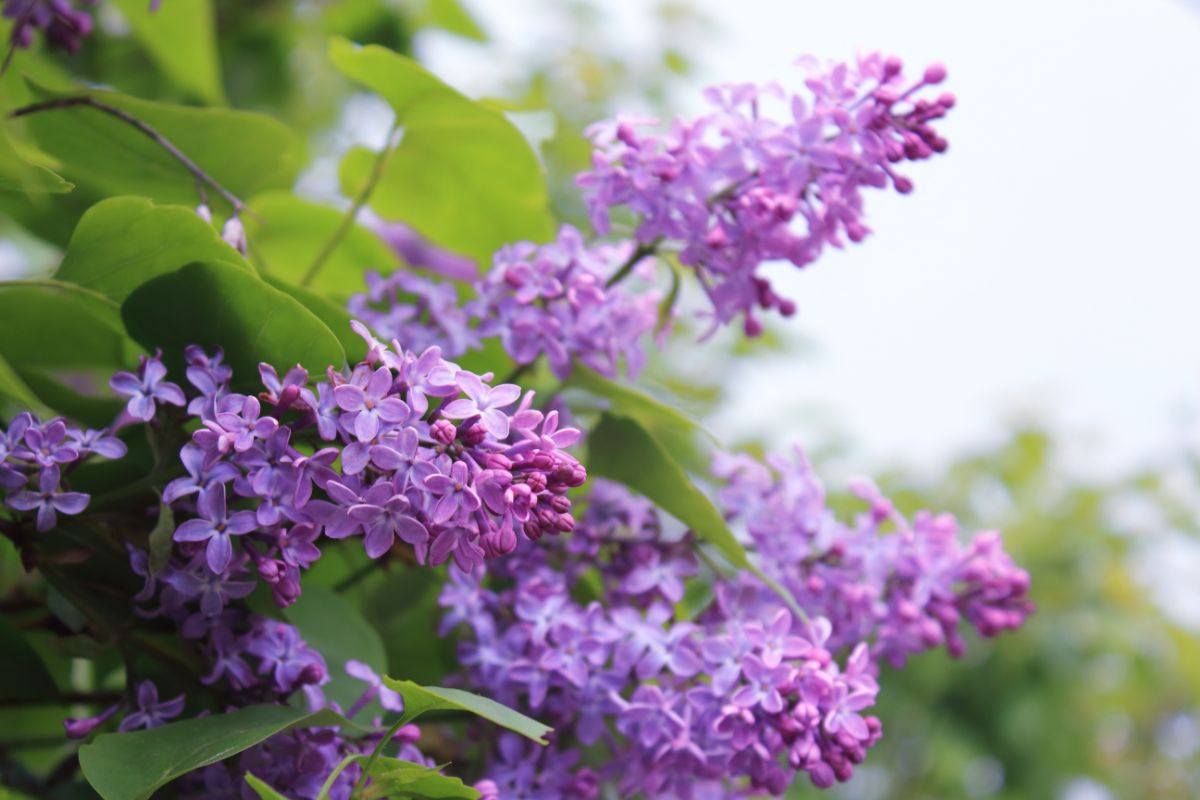
| Plant Type: | Lilacs |
| How to Grow: | Nursery starts |
| Lighting: | Full sun |
| Water: | Moderate |
| Minimum Grow Zone: | Zone 3 |
Lilacs bloom in spring, just when temperatures start to climb and the days begin to lengthen. In fact, lilacs and springtime are so intertwined, would it even feel like spring without these flowering bushes?
The best time to plant lilacs is in fall, which will ensure your plants will have enough time to settle in before winter. Often new plants will bloom the following spring with flowers appearing in April to May and generally lasting for a few weeks.
Lilac flowers most commonly come in purple or white clusters that are highly fragranced. If you love the scent, try planting lilacs by your front door or back patio so you can enjoy these stunners to the fullest.
While lilacs are often rather large shrubs, growing over 15’ tall, there are dwarf varieties available too if you’re working with a smaller space.
Where to buy bulbs?
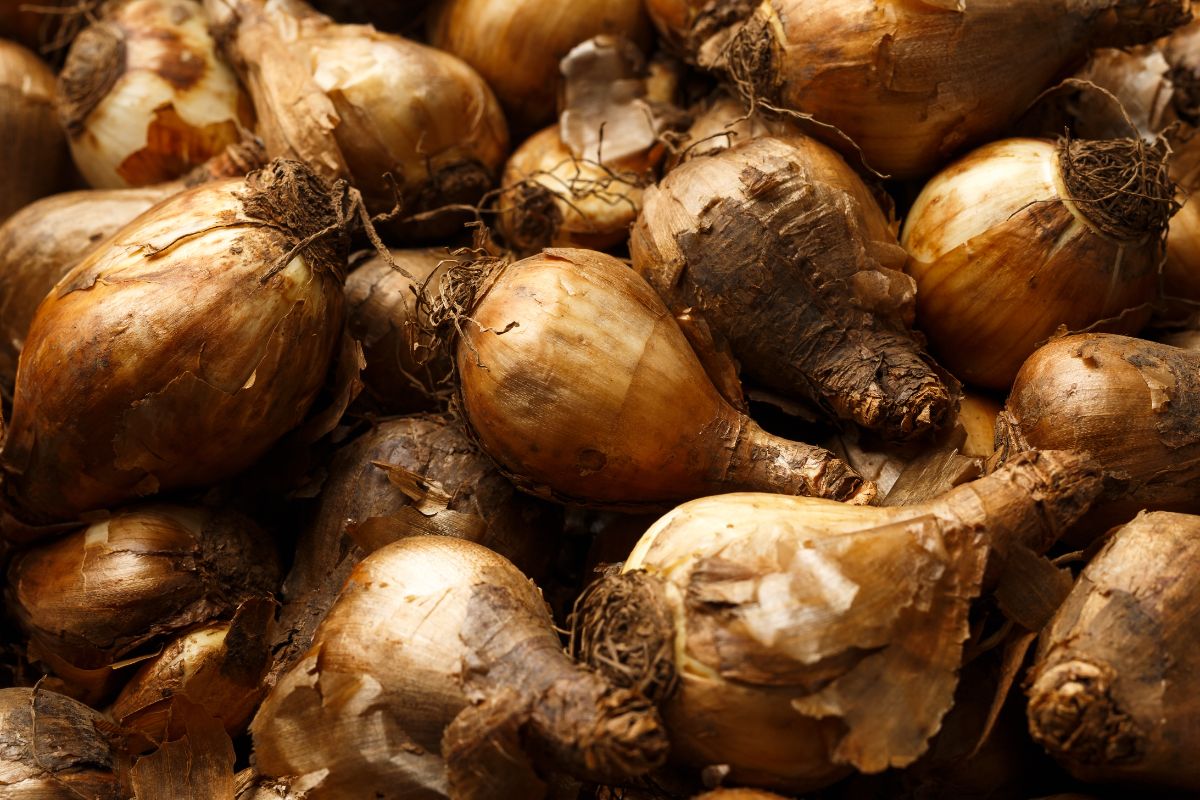
If you want to plant autumn bulbs, you’ll need to find a reliable grower first. Many common bulb varieties, like crocuses and daffodils, are available in local garden centers and nurseries; however, for unusual plants, you’ll likely need to look online.
Seed catalogs are a great place to start; however, pay attention to their shipping and ordering schedules. While some companies may offer bulbs for sale all year long, others may only ship bulbs out at certain periods of the year, such as summer or early autumn. Often, bulb companies will only ship out plants during the appropriate planting season, although placing your order early never hurts.
If you are interested in perusing available bulbs, subscribe to your favorite seed catalogs when you can. Usually catalogs are mailed out in December or January, so try to join any mailing lists before then. Companies like Fedco, Breck’s and Eden Brothers offer a wide range of common and hard to find species.
Checking websites like Etsy and Amazon is a great idea too as they often offer a selection of unusual bulbs.
When should I plant bulbs?
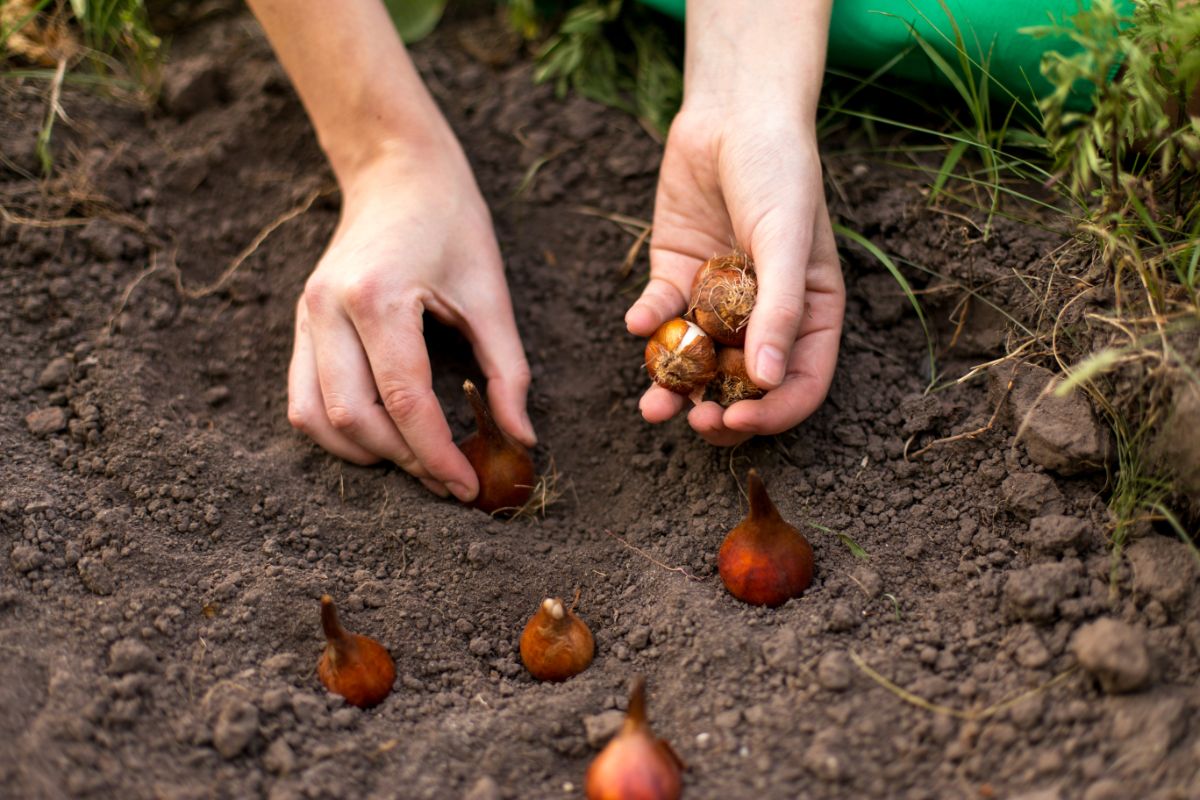
Bulbs need some time to develop roots before the winter chill begins in earnest. Giving your bulbs enough time to get established before winter is important for ensuring your new plants are strong enough to make it through the season. That’s why it is important to time your bulb planting correctly.
It’s always good practice to carefully read the planting instructions provided by your bulb grower. If your bulbs came in packaging, look for any details about time of planting and sowing requirements, such as hole depth and plant spacing. Usually, instructions will advise you to plant your bulbs several weeks before your first frost date, so it’s a good idea to learn your region’s first and last frost date and your growing zone.
Once you’ve determined your first frost date (or the average date when frost is first expected to arrive in your area), you can calculate when you should begin planting certain bulbs. Keep in mind that different bulb varieties should be sown at different times.
A good rule of thumb is to plant bulbs about 6 to 8 weeks before your first frost date, while soil is still very workable. For growing zones 5 and 6, that is usually around October, while warmer areas may need to wait until November or even later to begin bulb planting.
In general, bulbs can be planted anytime between September and Christmas, but this varies based on bulb type and growing region. Just make sure your bulbs have enough time after sowing to establish feeder roots, which will help anchor bulbs in the soil and provide them with water during the seasons ahead.
That said, be careful not to sow bulbs too early because you don’t want them to sprout in fall and waste valuable energy they need to survive the winter.
How do I find my region’s first and last frost date?

Before planting anything in your garden, it’s important to learn your region’s growing zone, as well as your first and last frost dates. This information is essential for determining which plants can grow as perennials in your garden and when to plant bulbs and other flowers.
The easiest way to figure out your frost dates is to use the Old Farmer’s Almanac website. Simply input your zip code and the search engine will provide you with your frost dates, as well as the approximate length of your growing season. Once you know your first frost date, you can easily calculate when you should start planting your bulbs.
If you prefer working with books, the Old Farmer’s Almanac also publishes a printed guide every year, which provides information about your growing region and other helpful gardening tips.
Basics of autumn bulb planting
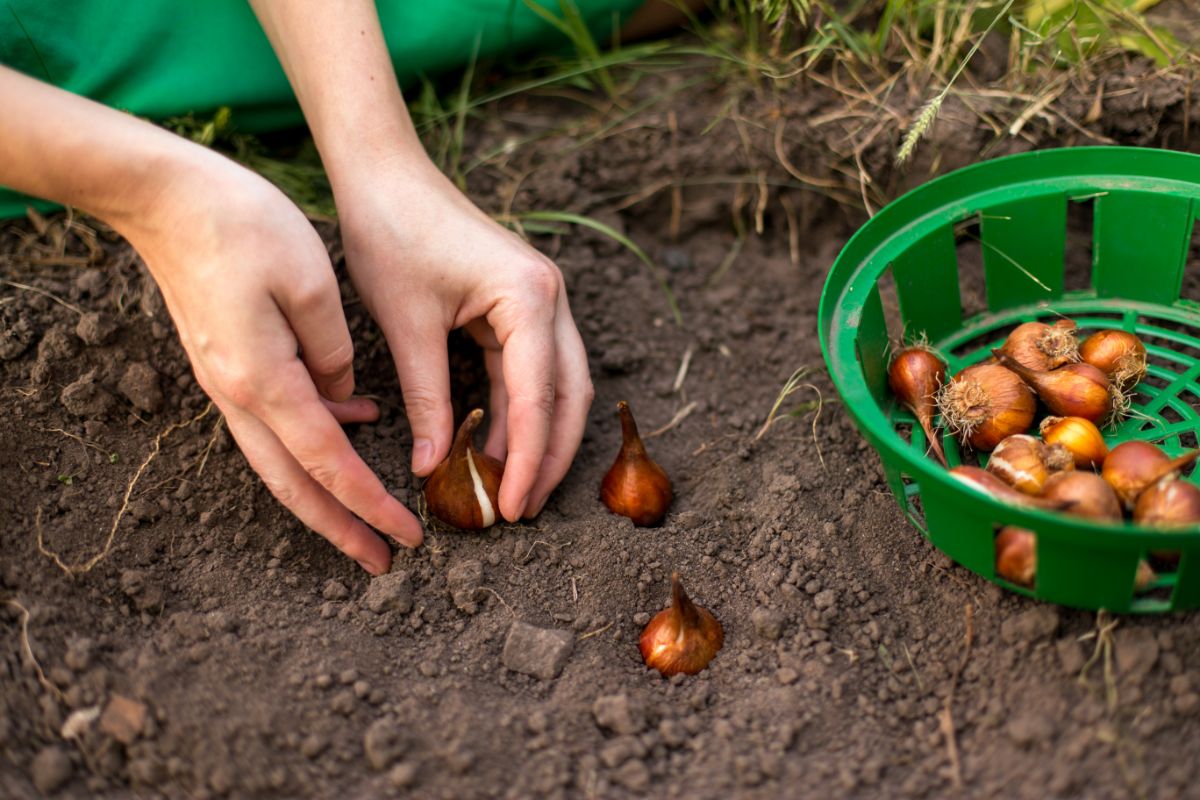
Once you receive your bulbs, check them over carefully. Healthy bulbs should be nice and plump and feel hard, not mushy, when touched. If any bulbs feel soft, compost them so as not to allow rot to spread to your other bulbs. It’s also important to do your best not to remove any of the papery skin covering your bulbs.
Short-term bulb storage
If you ordered bulbs from a seed catalog or other dedicated plant nursery, they likely have been mailed to you at just the right time for fall planting. If, however, you aren’t able to plant your bulbs right away, be sure to store them safely in a cool, dry area and out of direct sunlight. Don’t store your bulbs on top of your fridge or in another area that might accidentally warm up. Instead, opt for a safe location, such as a dark cabinet or closet or in a dry basement.
When storing bulbs, you’ll want to do everything you can to keep them from sprouting. Sprouted bulbs will use up the valuable nutrients they need to survive the winter and may be weakened or nonviable as a result. Sunlight can encourage sprouting, as can warm temperatures. Specifically, lily bulbs should be stored below 45° F as temperatures above this range can make plants begin to grow.
And, while it’s important to keep bulbs cool, don’t let them freeze. Frozen bulbs may become mushy and won’t grow as a result.
Planting
When you’re ready to plant your flower bulbs, be sure to follow all planting instructions provided by the grower and pay special attention to sowing time, planting depth and spacing.
Most bulbs need to be planted between 3 and 8” deep; however, that depends on the species and your growing zone. Handheld bulb planters can make sowing a breeze, while the depth measurements provided on hori hori’s sleek blade ensures you’ll always plant bulbs at the appropriate depth.
If you have a bad back or simply a lot of bulbs to plant, opt for the handy bulb planter offered by ProPlugger, which allows you to do all your bulb planting while standing.
As far as soil amendments go, gardeners used to recommend adding bone meal to bulb holes while planting; however, that practice has lost popularity in recent years. Instead, try amending your soil with aged compost or worm castings when you plant your bulbs to give your new plants a quick energy boost. Simply mix a bit of compost or worm castings into the soil you remove from your bulb holes and then fill the holes back in with the enriched soil. It’s as simple as that!
Conclusion
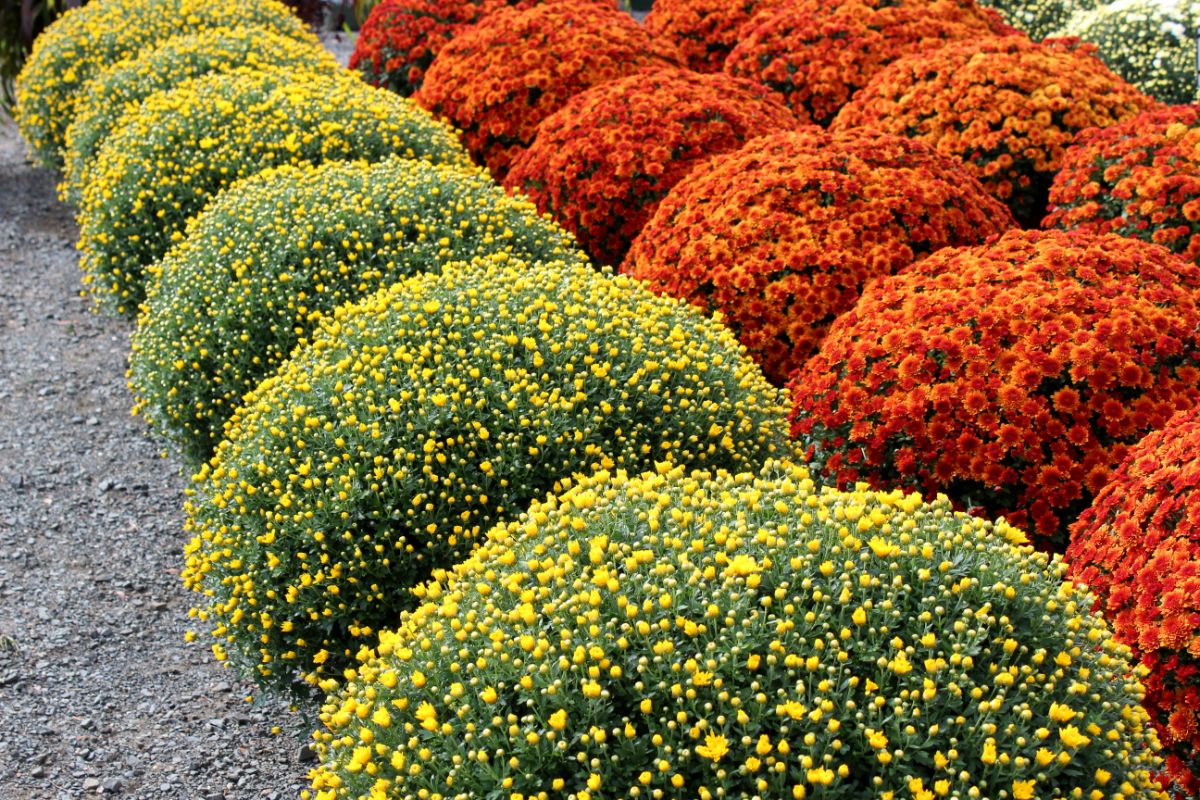
If the seasons got away from you and spring and summer sped by, there’s still plenty of time to do gardening in fall. In fact, autumn is usually one of the best times to get creative with your garden and to plan for the future. If you want to divide perennials, reshape beds or add new specimens, fall is the time to do it.
So, if you’re looking for inspiration to change up your garden this season, try out some of the flowers we’ve explored today in your fall planting. Some of these plants are great for immediate gratification. They’re the plants, like mums, that will bloom this season, offering lots of color at a time when early-bloomers are fading. Other plants we’ve listed are the perfect choices for future garden plans. They’re the plants, like bulbs and long-lasting shrubs, that are best sown in autumn to ensure they’re ready for the springtime blooming season.
Whether you opt to create a tulip bed or a temporary autumnal planter for your back porch, it’s up to you. Whatever flowers you choose to plant this fall are sure to enrich your garden space in very tangible ways. So get planting, try something new, order some bulbs and experiment with some flowering bushes.
A gardener’s work is never done… but we like it that way!


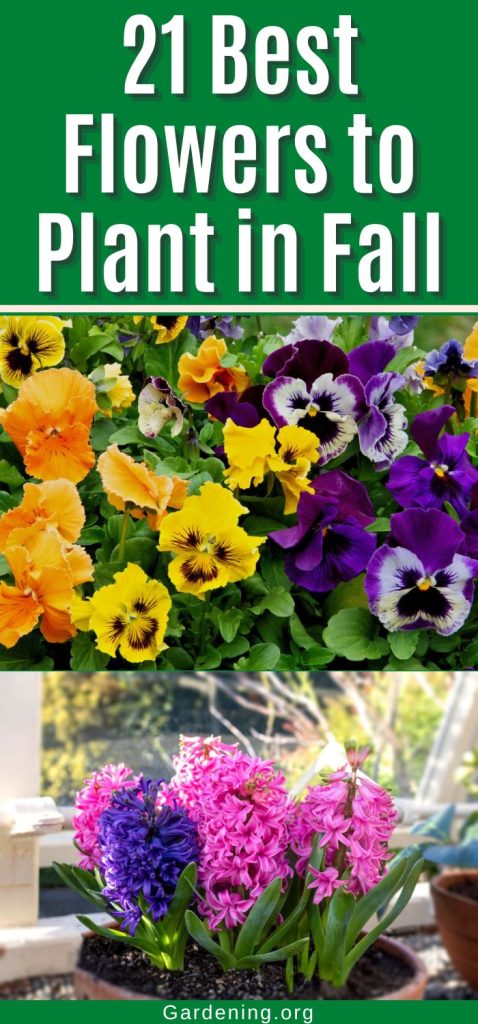
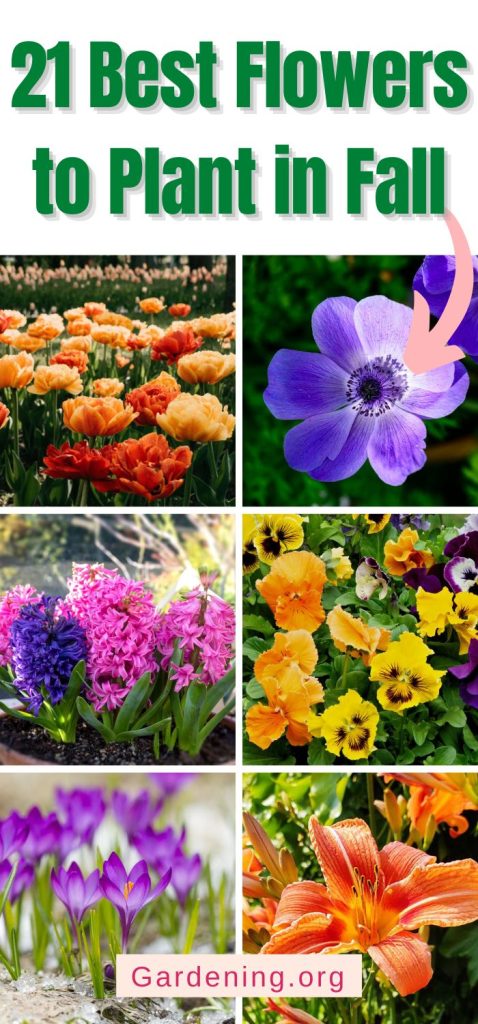
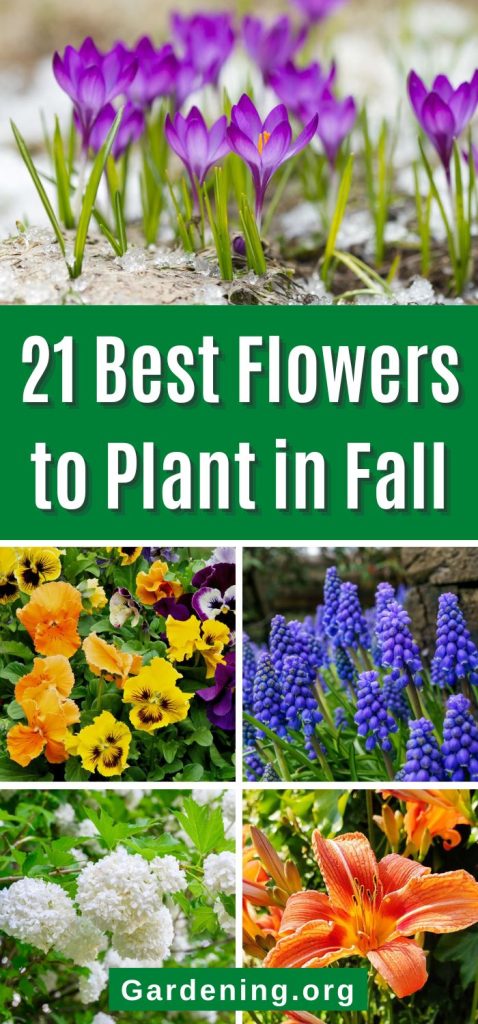

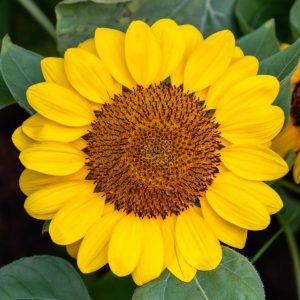
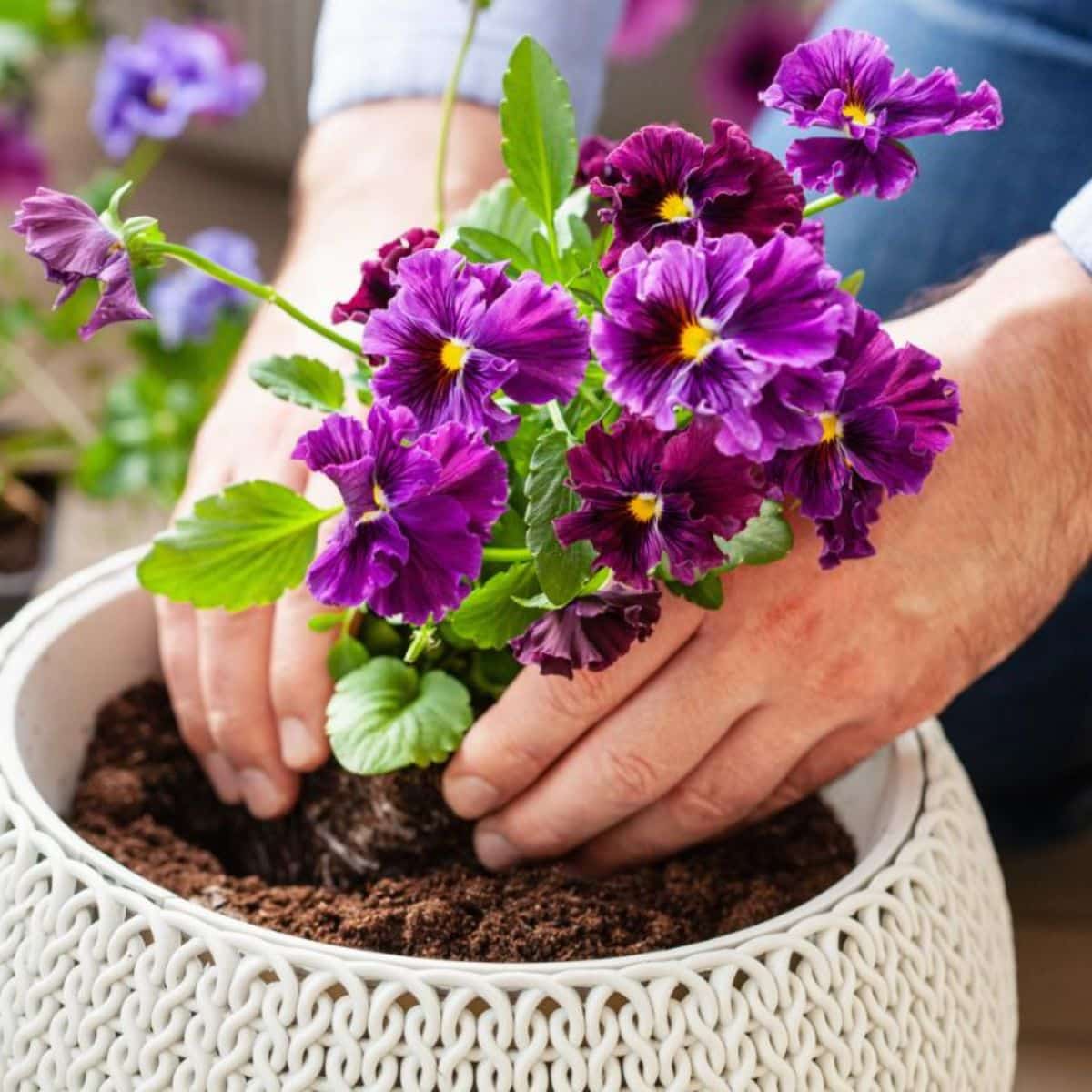
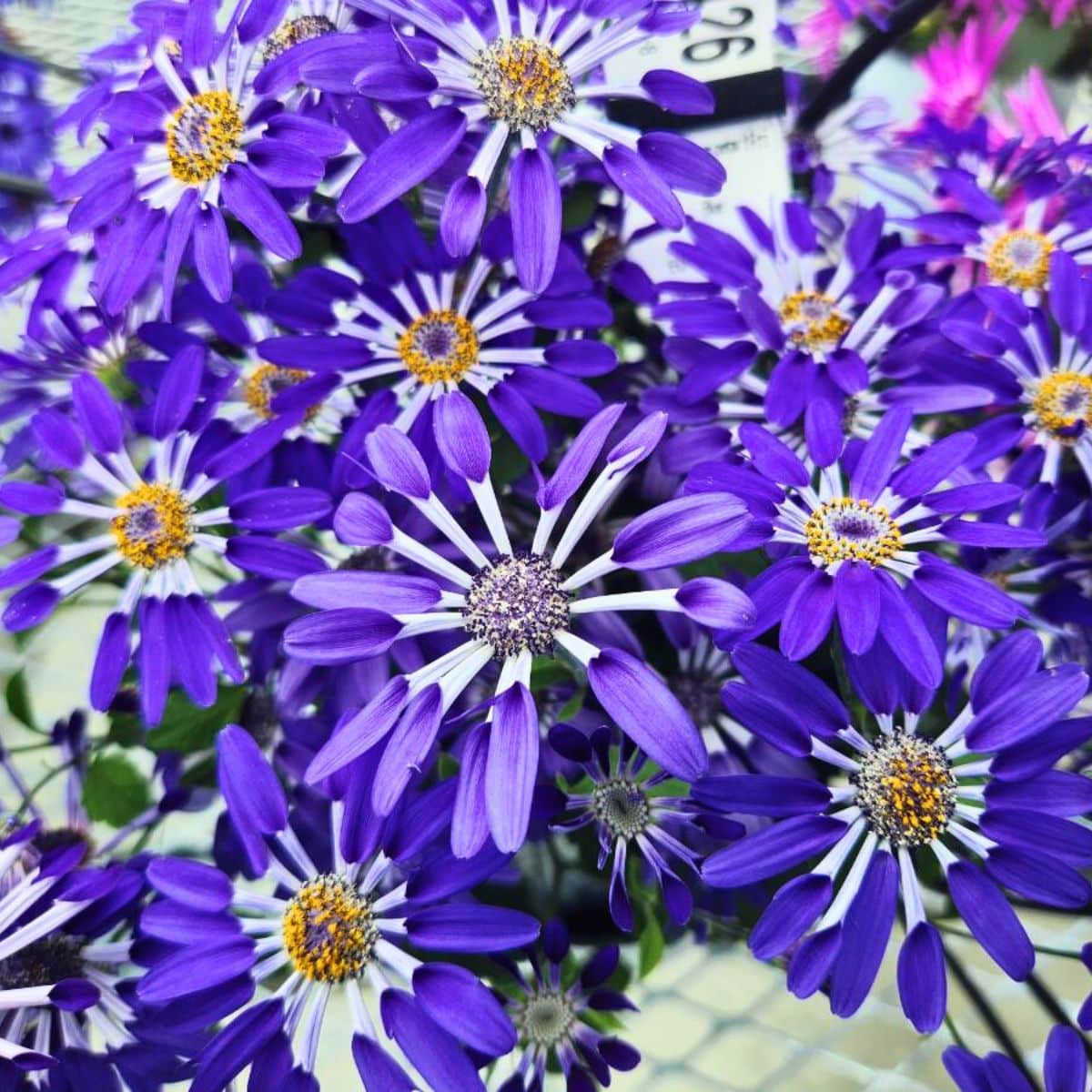
Deb Dennis
Thanks for all the info on bulbs.